Saturday, 12 August 2023
The bodhisattva at the back
One of the biggest obstacles to studying Gandharan sculpture is the loss of provenance – information about the archaeological origins of these works of art, as well as their biographies since they left the ground. This has resulted from a mixture of illicit excavation, the drift of found objects onto the antiquities market, and undocumented or poorly documented excavations in the colonial era (and since). Consequently, early photographs of discoveries are invaluable for documenting where Gandharan sculptures came from. We have a number of important collections of late nineteenth- and early twentieth-century photographs that record the artefacts, if not quite
in situ, then at least in association with particular sites. The largest is a collection of several thousand photographs, many of them prints of old ASI (Archaeological Survey of India) images, held today in the British Library.
1 Smaller, important collections have been digitized by the Kern Institute in Leiden and London’s Warburg Institute, for example.
2
Many of the sculptures shown in these photos are famous. A lot of them ended up in major museums in India and Pakistan, as well as the British Museum. But others are unaccounted for. Moreover, the provenance even of well known sculptures has sometimes been forgotten. Embedded in the antiquarian photographs is a trove of lost information about the origins of these important works.
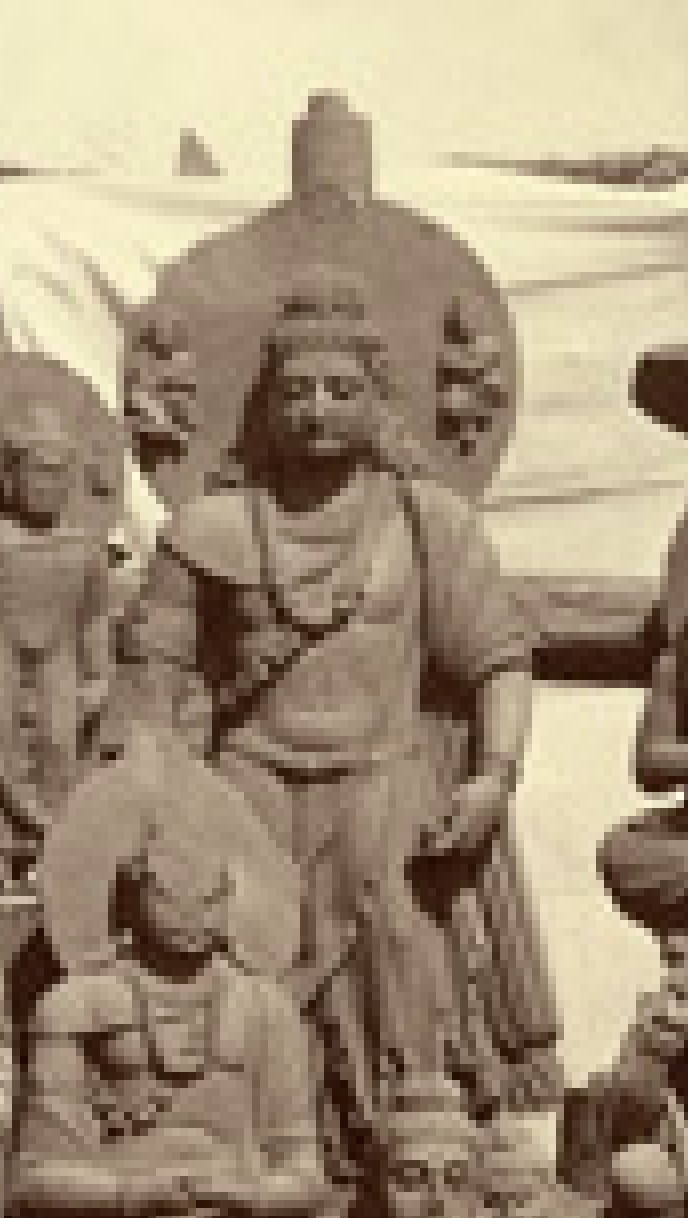
Figure 1. (a) Photograph of sculptures found at Loriyan Tangai, by Alexander Caddy, 1896. (b) Detail. (Photo: British Library.)
A much reproduced image preserved both in London and Leiden offers an illustration (Fig. 1a).
3 It is a huge group photo of Buddhist sculptures recorded at Loriyan Tangai in 1896 by Alexander Caddy. It can be hard to distinguish the Buddhas and bodhisattvas of various sizes, which once decorated stupas and shrines at the site, and which reproduce very conventional iconography over and over again. But one figure is a little more distinctive: a tall bodhisattva Maitreya in the middle of the back row, whose nimbus (halo) is unusually decorated with reliefs of worshipping bodhisattvas in profile (Fig. 1b).
It is enough to allow us to spot the figure in a crowd, or in the rooms of a museum. And so we find it, almost certainly, in the Patna Museum in India, albeit now lacking a face! The provenance of this imposing statue has been forgotten. Gupta’s catalogue of the Museum says vaguely that the bodhisattva comes from the Swat Valley.
4 Francine Tissot, who used it as an example in her indispensable handbook
Gandhâra, simple states: ‘provenance unknown’ (Fig. 2).
5 Thanks to Caddy, it is now known again. This is not a unique example. For instance, a provenance study completed in 2015 by Lubna Sen used British Library photographs to identify two Gandharan sculptures in the Indian Museum collection in Kolkata.
6 These historic images still have much more to tell us.
[Peter Stewart 12/8/2023]
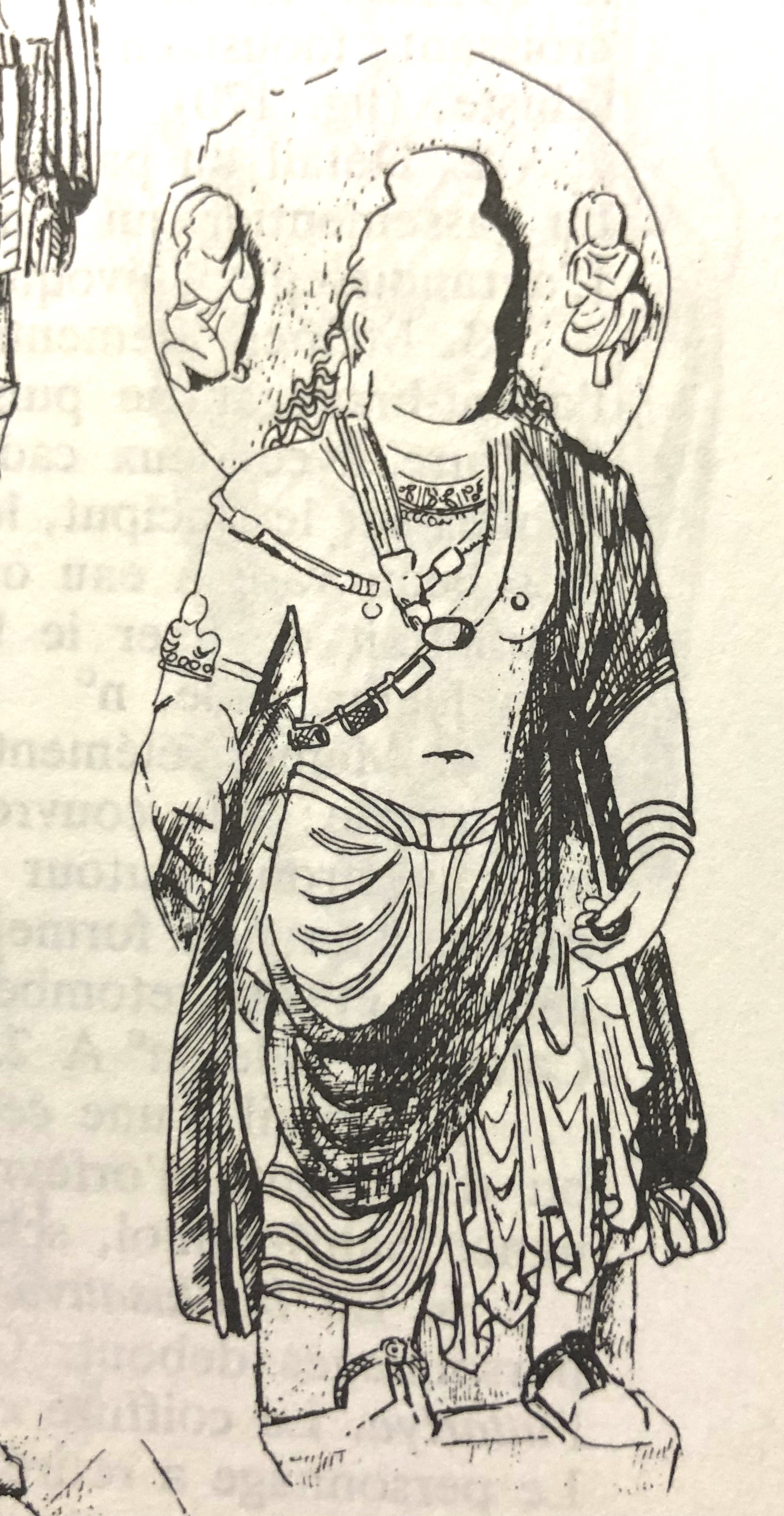
Fig. 2 F. Tissot’s drawing of the Patna sculpture.
[1] A small sample. Has been digitized so far:
https://explore.bl.uk/primo_library/libweb/action/dlSearch.do?query=any,contains,gandhara&vid=BLVU1&institution=BL&search_scope=LSCOP-WEBSITE&tab=website_tab
[2]
https://digitalcollections.universiteitleiden.nl/photography-kern ;
https://iconographic.warburg.sas.ac.uk/categories
[3]
https://www.bl.uk/onlinegallery/onlineex/apac/photocoll/g/019pho000001003u01042000.html
[4] P.L. Gupta,
Patna Museum Catalogue of Antiquities (Patna: Patna Museum, 1965), 34, no. 33 (inv. 1325).
[5] F. Tissot,
Gandhâra (2nd edn.) (Paris: Librairie d’Amérique et d’Orient), 199, pl. 23.3 and fig. 120.
[6] L. Sen, ‘Exploring an integrated approach to re-assess and authenticate museum documentation: Case study of the Gandhara Collection of Indian Museum, Kolkata’ (post-conference report for CIDOC 2015) https://cidoc.mini.icom.museum/archive/past-conferences/2015-new-delhi/ (consulted 11 August 2023).
Posted by Peter Stewart, CARC at 20:04
Thursday, 3 January 2019
Fom Lahore to Bologna: A Gandhāran Connection
This guest post by Italian curator and Indologist Luca Villa summarizes the history of a large and fascinating archive of photographs formed more than a century ago by Professor Francesco Lorenzo Pullè, and now preserved in Bologna’s Museo Civico Medievale. An exhibition curated by Dr Villa, Faces of the Buddha from the Lost Museo Indiano,
runs at the museum until 28th April 2019.
The extensive series of pictures acquired by Francesco Lorenzo Pullè (1850-1934) at the Lahore Central Museum between January and February 1903 were first exhibited in April of that year, when he had returned from his travels around the Indian Subcontinent. They were displayed at the Congresso Internazionale di Scienze Storiche (International Congress of Historical Sciences) held in Rome. When he was in Lahore, Pullè had also acquired also lantern slides of the same artefacts, which are now lost, and a plaster-cast of the fasting Śākyamuni still preserved in Lahore, probably guided in his choice by the then Surveyor Jean-Philippe Vogel.
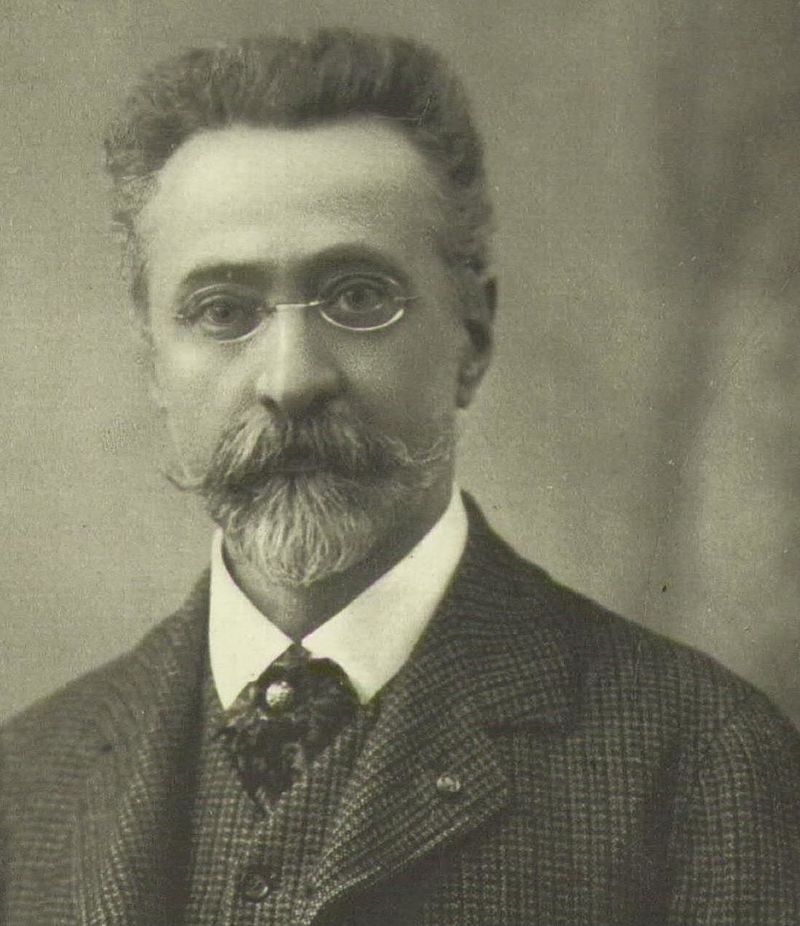
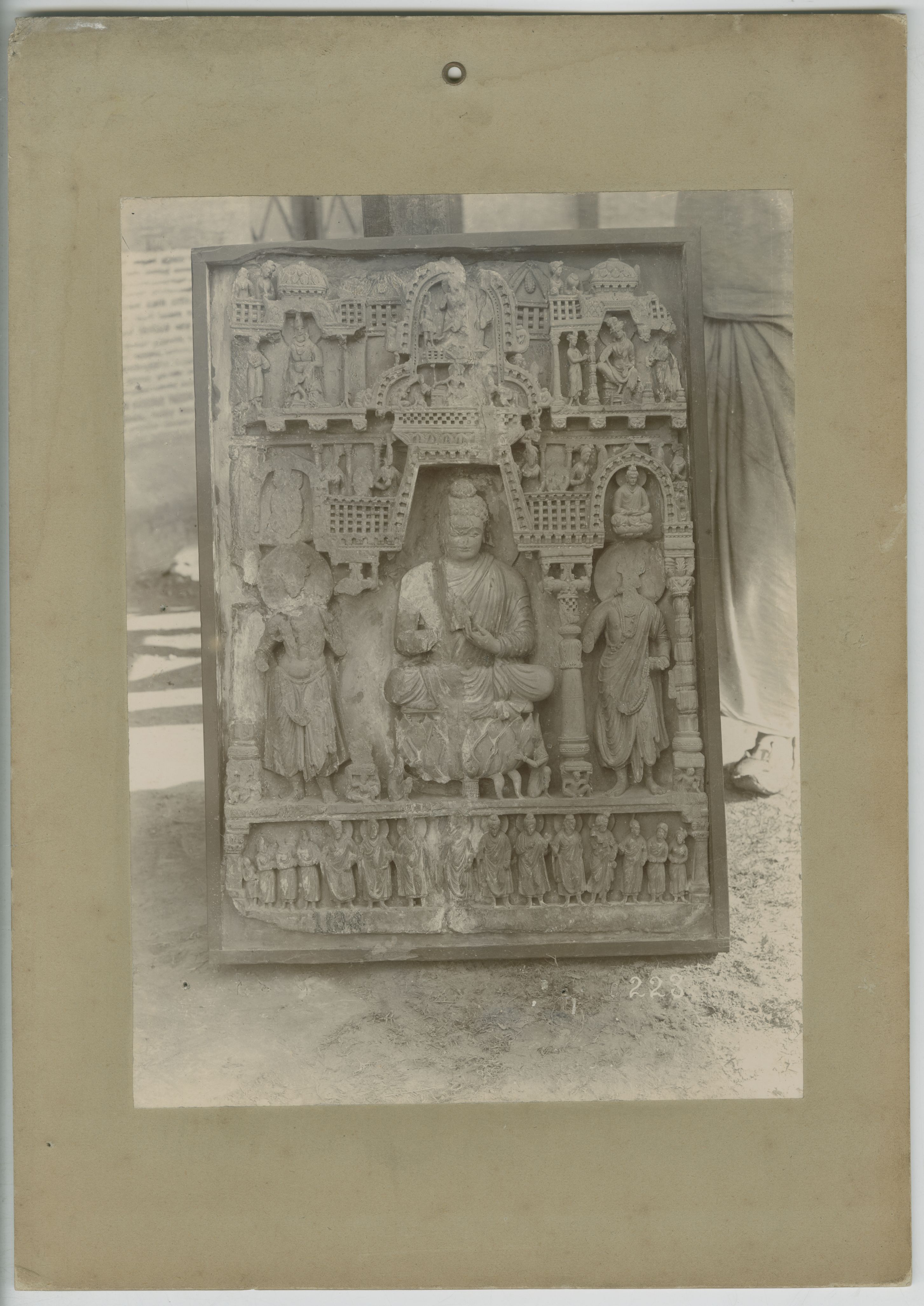
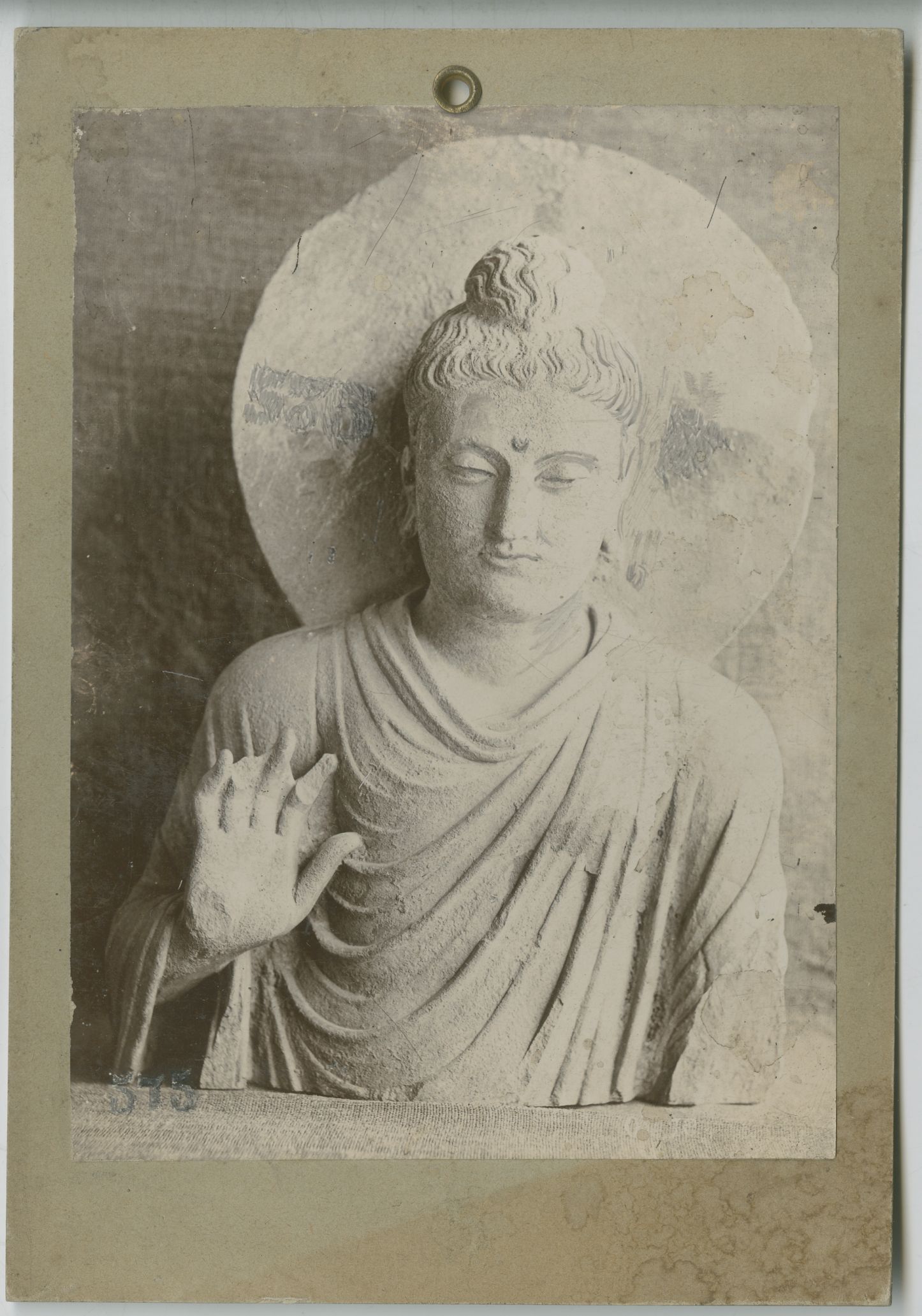
Photo of Francesco Lorenzo Pullè from
Archives of the Senate of the Italian Republic (public domain); other images courtesy of Luca Villa.
In 1907, Pullè was successful in opening the Museo Indiano in Bologna, where at that time he taught Sanskrit at the local university, the Bologna Alma Mater. The walls of one of the nine rooms of the Museo Indiano were completely packed with photographs, not only representing the Gandhāran relics, but also views of the Mahabalipuram temples and monuments, as well as some different pictures related to other kinds of Indian Hindu architecture. Among the photographs appeared a sculptural fragment depicting two merchants or princely figures, that possibly came from the Sanchi Tope area, but was acquired by Pullè in Lahore, as contemporary documents report.
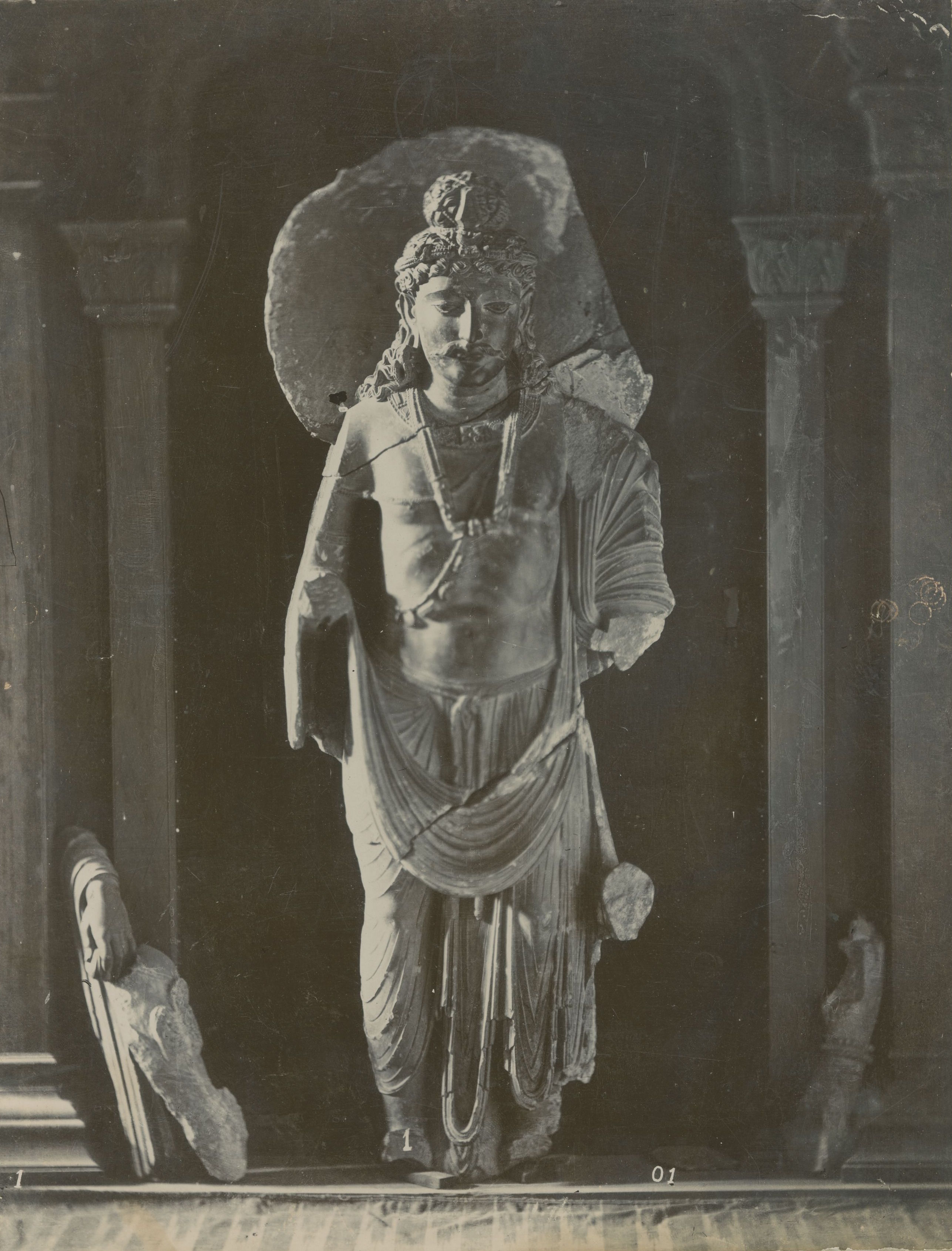
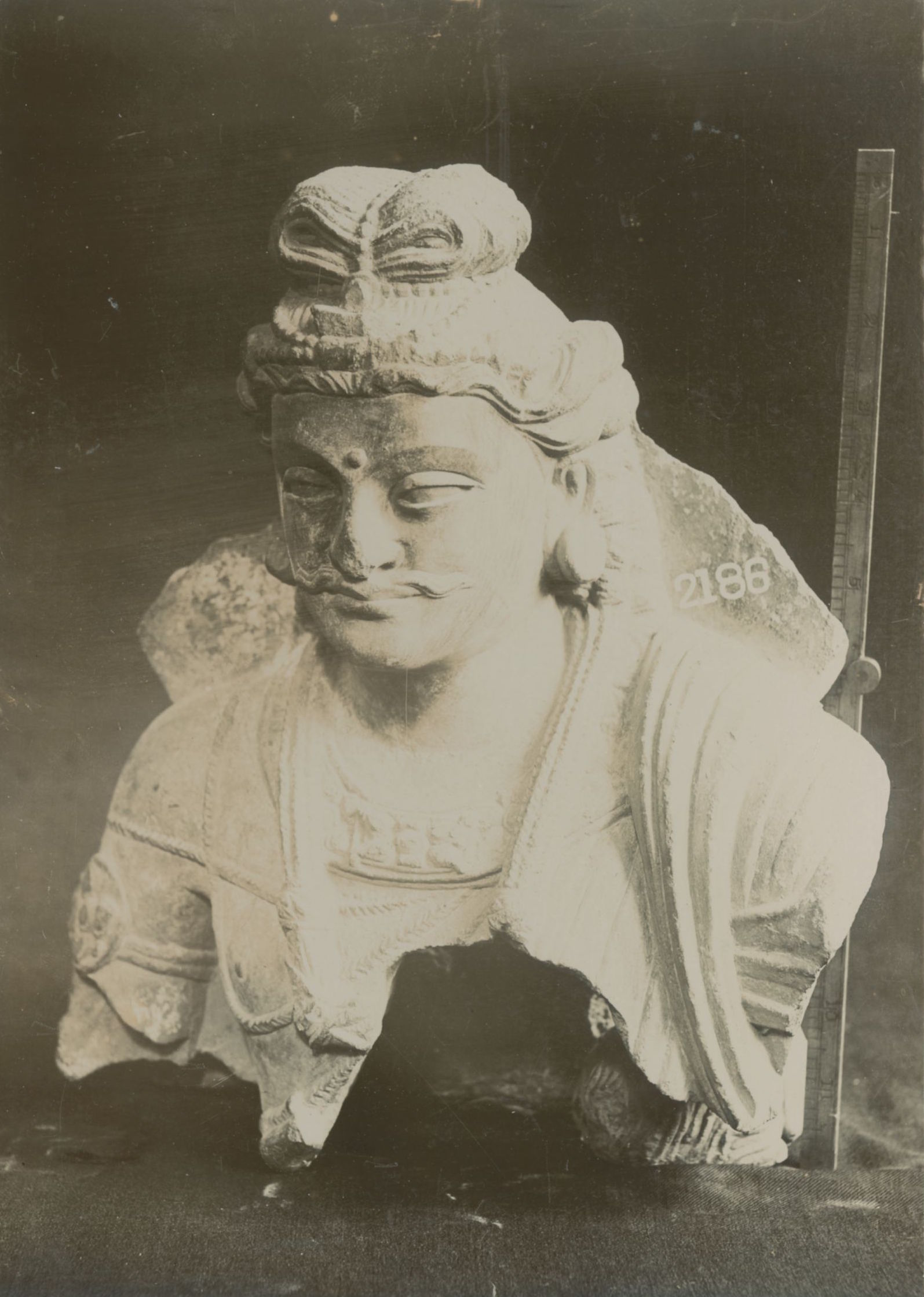
The Museo Indiano closed in 1935, only one year after Francesco Lorenzo Pullè’s death. In the meantime the energetic professor managed to enrich the collection with statues representing the Buddha and a Bodhisattva, which some private collector sold to the museum. They stood in the same room were the plaster cast of the fasting Śākyamuni had been placed.
A digital catalogue of Pullè’s photographic collection is now available online and more information about the Museo Indiano is to be found on a dedicated website by the author.
Luca Villa, 3/1/2018
PhD in Indology and Tibetology; Curator of the exhibition
I volti del Buddha. Dal perduto Museo Indiano di Bologna.
<villagood@gmail.com>
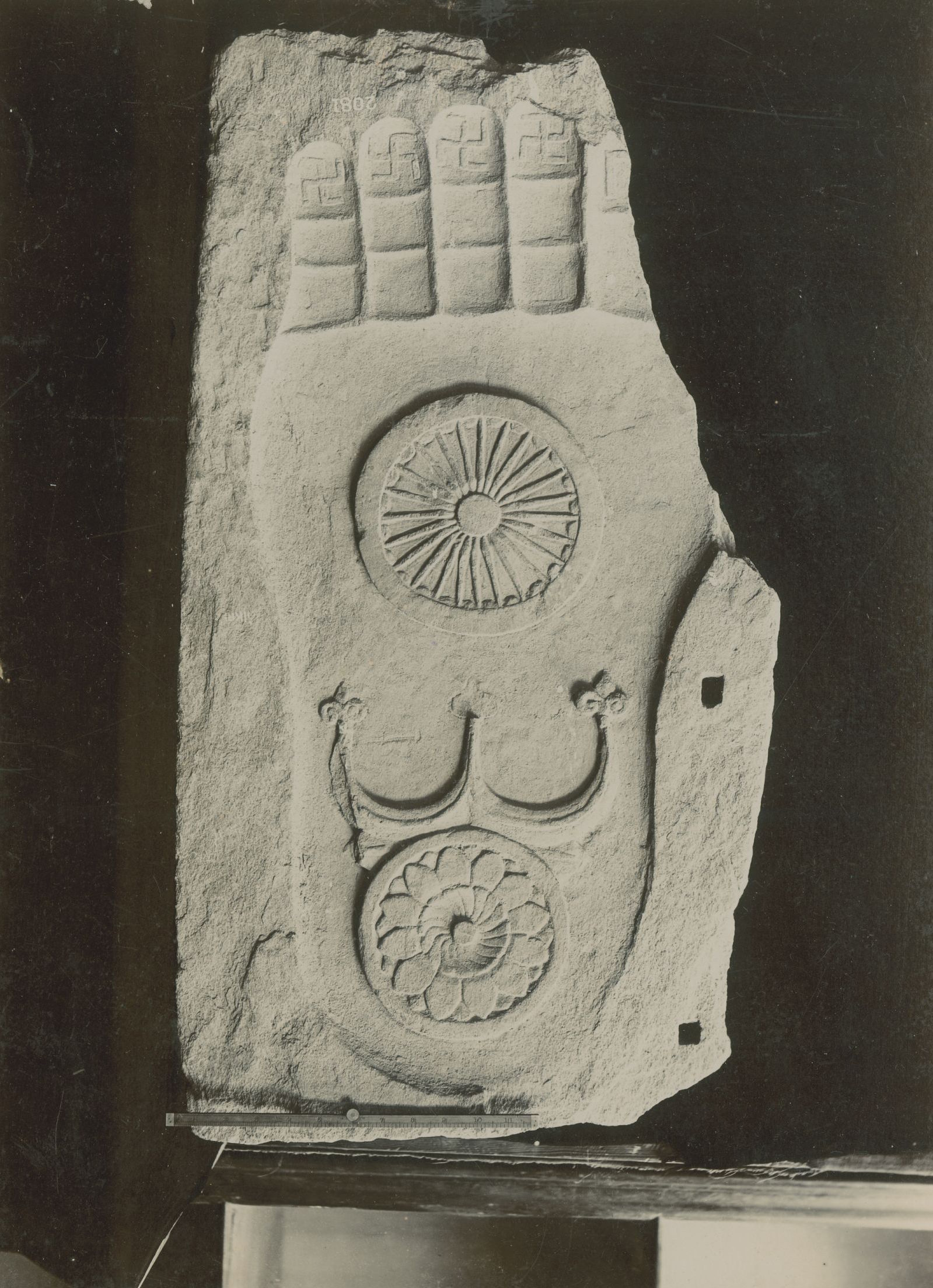
Posted by Peter Stewart, CARC at 14:53
Saturday, 21 July 2018
Geographic units in Gandharan art – a suggestion
In this guest post, our International Advisory Board member Dr Jessie Pons (Bochum University) presents ideas arising from her paper at the 2018 Gandhara Connections workshop on The Geography of Gandharan Art (the proceedings of which will be published in 2019). Dr Pons suggests a terminology for site clusters/geographic units in the study of Gandharan art, and invites comments.
In producing the preliminary inventory for my PhD research, I was confronted with an unexpected difficulty related to the definition of archaeological sites. By ‘definition’ I mean something as straightforward as designating a site with a name and its precise geographic localisation. The tumultuous history of the region which was under British rule and which then became a province of Pakistan (Khyber-Pakhtunkhwa, known as the North-West Frontier Province until 2010), as well as the structural evolution of institutions in charge of the study and preservation of its archaeological heritage complicate the reconstruction of the archaeological map. The same site can be attributed to one of the Circles of the Archaeological Survey of India, and to one of the administrative divisions created after the formation of Pakistan in 1947.
The discrepancies are numerous and I have attempted to find solutions. Geographic coordinate system/GPS tracking is of course one (when it comes to mapping sites), yet within the frame of my doctoral research I needed a terminology to refer to the geographical units to which the sites belong. Sites may cluster in an area (for instance Jamālgaṛhī/Sikṛi/Thareli or Takht-i-Bāhī/Muhammad Nāri/Sahrī Bāhlol) and one can observe reoccurring formal and iconographic patterns in art across the cluster. What name should we give to this area, as well as its sculptural language(s)? I have come down on the side of physical geography, which is more constant than historical or political geography, and formulated a terminology whereby the denomination is no longer determined by the name of people or modern frontiers but by that of rivers, mountains, and valleys. A list of these is given in the table below. (Click here to download the whole table as a single pdf.)
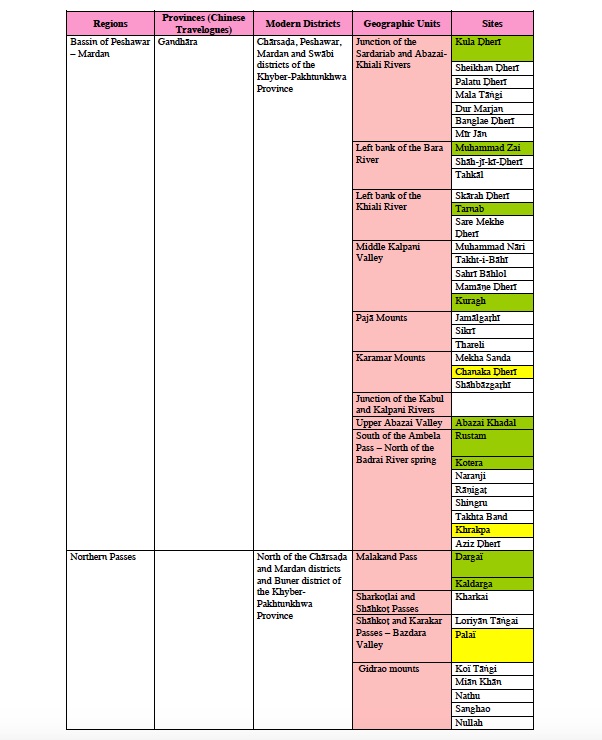
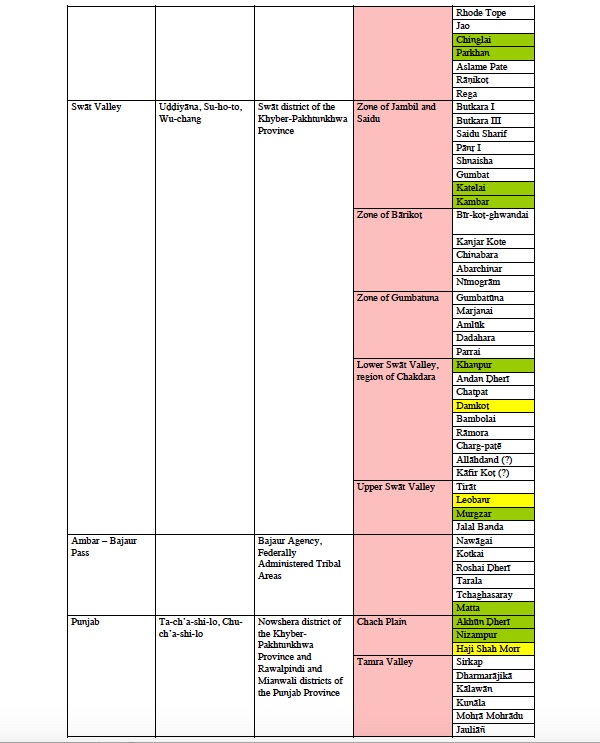
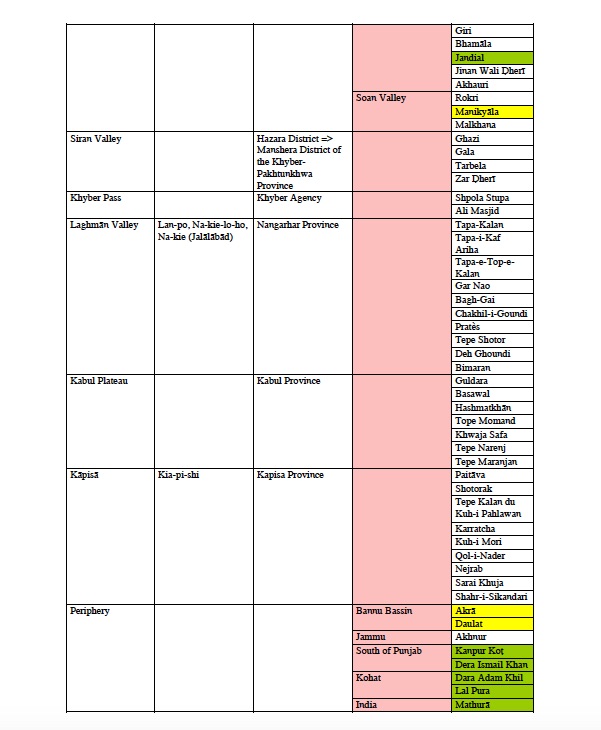
I would like to use this terminology in my future research. Before I apply it in any forthcoming publication (the first in line being the proceedings of the Gandhara Connections workshop, ‘The Geography of Gandhara Art’, which took place in March 2018), I would like to invite colleagues to react to the suggested terminology (particularly the column ‘Geographic Units’), comment upon it, amend it, complement it (or discard it!). I am certain that it would greatly benefit from the expertise of colleagues who have been working on/in the region for a long time and who are more familiar than I am with its physical geography. I would be very grateful for any type of reaction and will not fail to credit any assistance received in my work.
NB: The list of sites provided is non-exhaustive and primarily takes into account those which have yielded adequately documented sculptures. For general information, this list gives:
- In green, sites having yielded sculptures, but their archaeological context could not be ascertained
- In yellow, Buddhist sites where no sculpture was found.
The correspondence between the different geographic categories is only indicative and does not represent one-to-one equivalents.
Responses to this proposal can be made through the blog or by emailing carc@classics.ox.ac.uk – we will pass any comments on to Dr Pons.
Posted by Peter Stewart, CARC at 21:48
Sunday, 26 November 2017
The Bimaran casket: problems of production
The Bimaran casket, discovered by the British explorer Charles Masson in the 1830s, has long been an object of curiosity amongst art historians for many reasons. It was found inside a Buddhist stupa in the Darunta district, west of Jalalabad in eastern Afghanistan. The fact that the casket bears images of the Buddha and Indian deities and was found with coins of the first to early second century AD appears to place this casket in the context of the earliest Buddha imagery. Indeed it has played a key role in debates about the origins of the anthropomorphic representation of the Buddha.
The origin of the Buddha image remains a topic of much interest, but where does the casket fit within this story? Where and when was it made? Not only are such questions difficult to answer, but the practice of relic cult is in itself a complicated matter. Coins and other objects inside reliquaries can be used for dating, yet these objects were not always buried inside the stupa at the same time as each other. In the event of a re-consecration of relics, a new object could have been added to the original assemblage, and it is not impossible this could have been the case for the Bimaran casket. Needless to say, it is almost impossible to know whether the coins and the objects found in the same assemblage were produced at the same time.
If it is so hard, then, to say when the Bimaran casket was made on the basis of its contents, would it help if we knew who might have made it and where? Does examination of the iconography with its focus on the Buddha suggest that this casket was made in India, the motherland of Buddhism, and imported to Afghanistan? Or was it made somewhere closer to Afghanistan where Buddha imagery was also familiar, at least by the Kushan period? Could it have been made in an urban area where high-level of craftsmanship might be expected? What about the city of Sirkap (Taxila), for example? In short, could the artistic tradition and production techniques employed on this casket tell us something about its maker and place of origin?
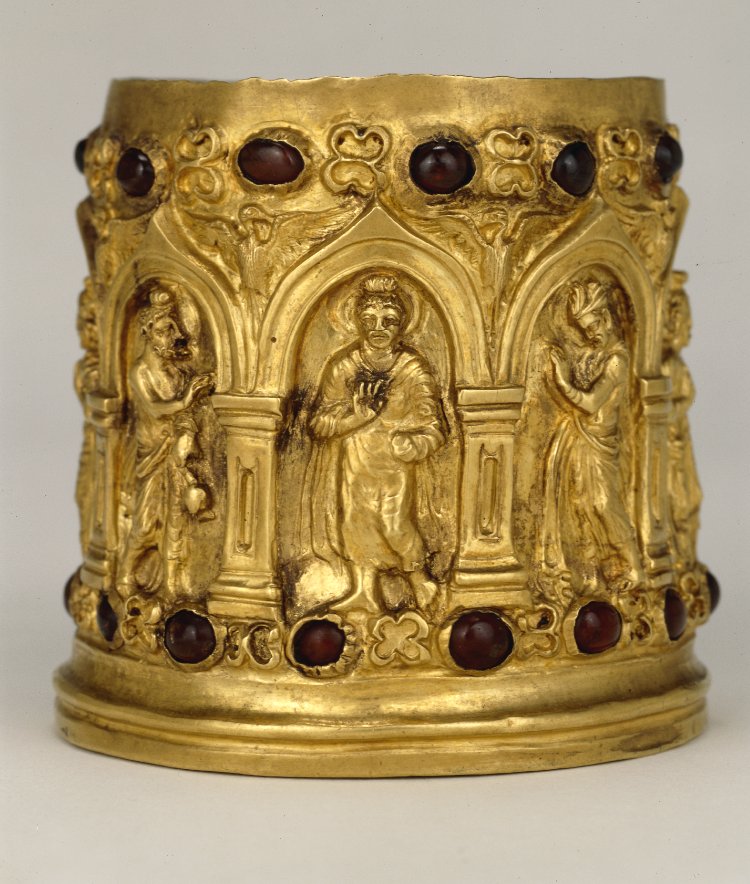

Fig. 1 Bimaran casket (BM1900.209). © the Trustees of the British Museum.
Fig. 2 Underside of base of the Bimaran casket (BM1900.209). © Wannaporn Rienjang. Courtesy of the Trustees of the British Museum
To begin with, the use of gold as a medium for a relic casket during the first and second century AD is rare in India, but rather common to 'Greater Gandhara' (an area that includes Taxila to the east and eastern Afghanistan to the west). What is not so common amongst the gold relic caskets in Greater Gandhara are the size and decoration of this Bimaran casket. While the height and diameter for the gold (or precious metal) relic caskets in Greater Gandhara commonly measure between 2.0 x 2.0 cm. and 3.0 x 3.5 cm., the Bimaran casket measures 6.5 cm in height and 6 cm in diameter. Gandharan gold relic caskets were generally made of plain hammered sheets of gold. The Bimaran casket was also made of hammered gold sheet but its distinctive characteristic is its rich, figural decoration that includes the Buddha, Brahma, Indra, and another unidentified figure, executed using repoussé and chasing techniques on the body (Fig. 1). Its base was also decorated with eight lotus petals (Fig. 2). The casket was also adorned with with garnet and turquoise inlays. No other relic casket in early India or in Greater Gandhara comes close to the level of this intricate craftsmanship.
This Lack of parallel objects in India and Greater Gandhara may prompt some of us to link the production of this casket with the Central Asian nomads, whose love of gold and high level of skills in metal-working are well known. A number of gold and silver vessels of high quality craftsmanship were found in the first century AD Royal necropolis in Tillya Tepe, northern Afghanistan (Sarianidi 1985; 2011). There are also parallel objects from this necropolis such as sewn-on items made of gold in similar in fashion to those found in the Bimaran relic deposit (Errington, forthcoming). One feature of the manufacture that links the Bimaran casket with traditions beyond India is perhaps the inlay of semi-precious stones inside sockets that were formed by separate sheets of gold joined to the body by soldering (Fig. 3). This technique occurs on objects associated with Central Asian nomads or people from eastern Iran. Some examples are the gold and silver vessels in the al-Sabah Collection with rows of garnet inlays on the neck (Figs. 4 & 5). The sockets for the inlays on these two vessels were made in the same manner as those on the Bimaran casket. The provenance of the al-Sabah vessels is not known, but the form and craftsmanship of the gold vessel has been associated with eastern Iran or Bactria during the first half of the first millennium AD (Carter 2015: 348-9), while the form and decoration of the silver vessel has been linked to the Seleucid Empire or Parthian Western Asia during late second to first century BC (Carter 2015: 72).


Fig. 3 Socket for the garnet inlay of the Bimaran casket (BM1900.209). Photo © Wannaporn Rienjang. Courtesy of the Trustees of the British Museum
Fig. 4 Gold vessel in the al-Sabah Collection (LNS 3141 I). Photo courtesy of Martha Carter (2015: 349, cat. 96)
It is not impossible that setting an inlay in this manner was a norm in Central Asia and adjoining areas. Interestingly, a different technique of setting an inlay was employed on a gold relic casket from a stupa in Afghanistan, not very far from where the Bimaran casket was found. This is the gold relic casket from the Ahinposh stupa east of Jalalabad. Unlike those on the Bimaran casket and the above two vessels in the al-Sabah Collection, the garnet inlays on this casket were set on an organic layer between two sheets of gold (Fig. 6). The coins found with this casket date perhaps about a century later, i.e. second/late second century AD (Errington & Fabrègues 1992).


Fig. 5 Silver vessel in the al-Sabah Collection (LNS 1520 M). Photo courtesy of Martha Carter (2015: 72, cat. 7)
Fig. 6 Gold relic casket from Ahinposh stupa (BM1880.29). Photo © Wannaporn Rienjang. Courtesy of the Trustees of the British Museum
Was the Bimaran casket a product of a Central Asian workshop? Was it made somewhere further away from Gandhara? Or was this technique also common in eastern Afghanistan where the casket was found? These questions remain to be answered and more evidence with provenance is needed. At least what we know is that the iconography of the Buddha and Indian deities are not local to Central and Western Asia during the first century AD. The contrast between production technique and iconography on this Bimaran casket perhaps also positions it as a good example of the variable transmission of techniques and iconography across regions and over time.
[Wannaporn Rienjang, 26/11//2017]
References
Carter, M. 2015.
Arts of the Hellenized east: precious metalwork and gems of the pre-Islamic era. London.
Errington, E. Forthcoming. The Buddhist remains of Passani and Bimaran and related relic deposits from south-eastern Afghanistan from the Masson Collection. In: J. Stargardt (ed.)
Relics and relic worship in the early Buddhism of South Asia and Burma.
Errington, E. and Fabrègues, C. 1992. Stupa deposit from Ahinposh, Jalalabad district, Afghanistan. In : E. Errington & J. Cribb.
The Crossroads of Asia: transformation in image and symbol. Cambridge, 176-77.
Sarianidi, V. 1985.
Bactrian gold: from the excavation of Tillya-Tepe necropolis in northern Afghanistan. Leningrad.
Sarianidi, V. 2011. Ancient Bactria’s golden hoard. In: F. Hiebert & P. Cambon (eds.)
Afghanistan: crossroad of the ancient world. London, 211-293
Posted by Peter Stewart, CARC at 11:44
Posted by Wannaporn Rienjang, Oxford University on 09/08/2018 at 21:50
Preliminary notes on possible production techniques of the Bimaran casket by Rachel Berridge, Senior Conservator of Department of Conservation, the British Museum, suggests that the garnet settings were not done by soldering but by pushing the gold sheet outward from the inside, and pushing the centre back to form a socket for the garnet. Once the garnet was set the gold sheet was wrapped over the edges of the stone to secure it. Such a clever techinique. It would be interesting to see some parallels.
Thursday, 14 September 2017
The Bakhshali Manuscript and Gandhara
Our colleagues at Oxford University's Bodleian Libraries have today revealed an exciting new discovery about one of the most important documents in the history of mathematics. The news is being been reported around the world for the light it casts on ancient Indian science.
1 But it is also profoundly relevant to the archaeology of Gandhara.
The fragmentary Bakhshali manuscript was discovered in proximity to a village near Mardan in the Peshawar Valley in 1881. It comprises 70 leaves of writing on birch-bark, a material customarily used for ancient texts in the region. The leaves were originally about 17cm wide x 13.5 cm high and probably constituted a much more extensive book than what now survives.
2 The language is a form of Sanskrit. When first studied by AF Rudolf Hoernle, it was found to be a mathematical text – not a
theoretical treatise but a collection of practically-orientated writings on the usage of mathematics – and evidently the earliest of its kind on the Indian Subcontinent. It contains mathematical problems and rules set in verse, as well as commentary.
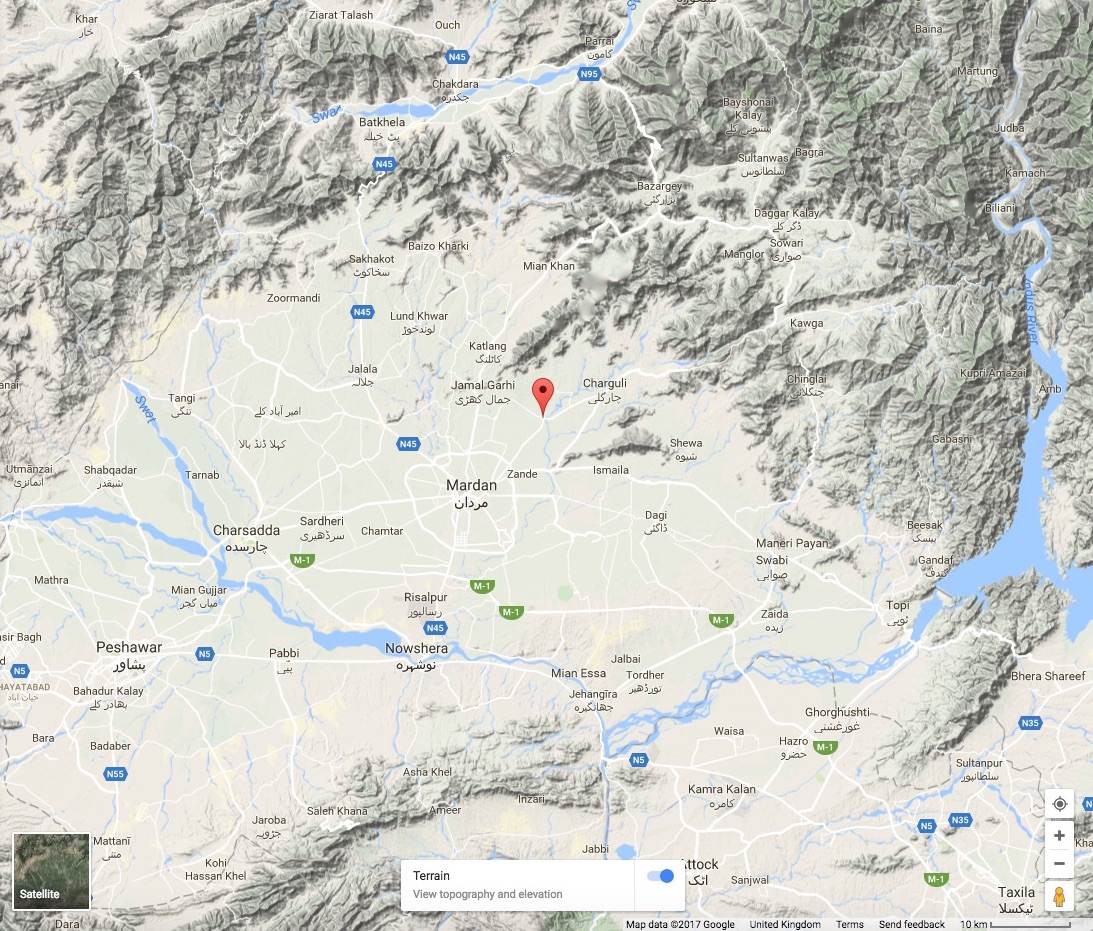
Location of the village of Bakhshali (Google Maps)
Such a discovery would have been astonishing and academically interesting in itself, but the Bakhshali manuscript attracted attention particularly because of its frequent use of a dot as a place-holder within numbers. This was the ancestor of '0' in modern mathematical notation, used to distinguish different orders of magnitude. Given that the manuscript was recognized to be ancient, the presence of this 'zero' equivalent was very exciting. Famously, it was ancient Indian mathematicians who devised the concept of zero as a number. Given its fundamental role in modern science and daily life, it is salutary to remember that most ancient cultures never fully developed the idea of 'nought' and its arrival in India seems to date only to the early middle ages. Indeed the first securely dated occurrence of the dot-symbol for zero in Indian mathematical notation has been thought to be that carved on a temple in Gwalior (Madhya Pradesh) in the middle of the ninth century.

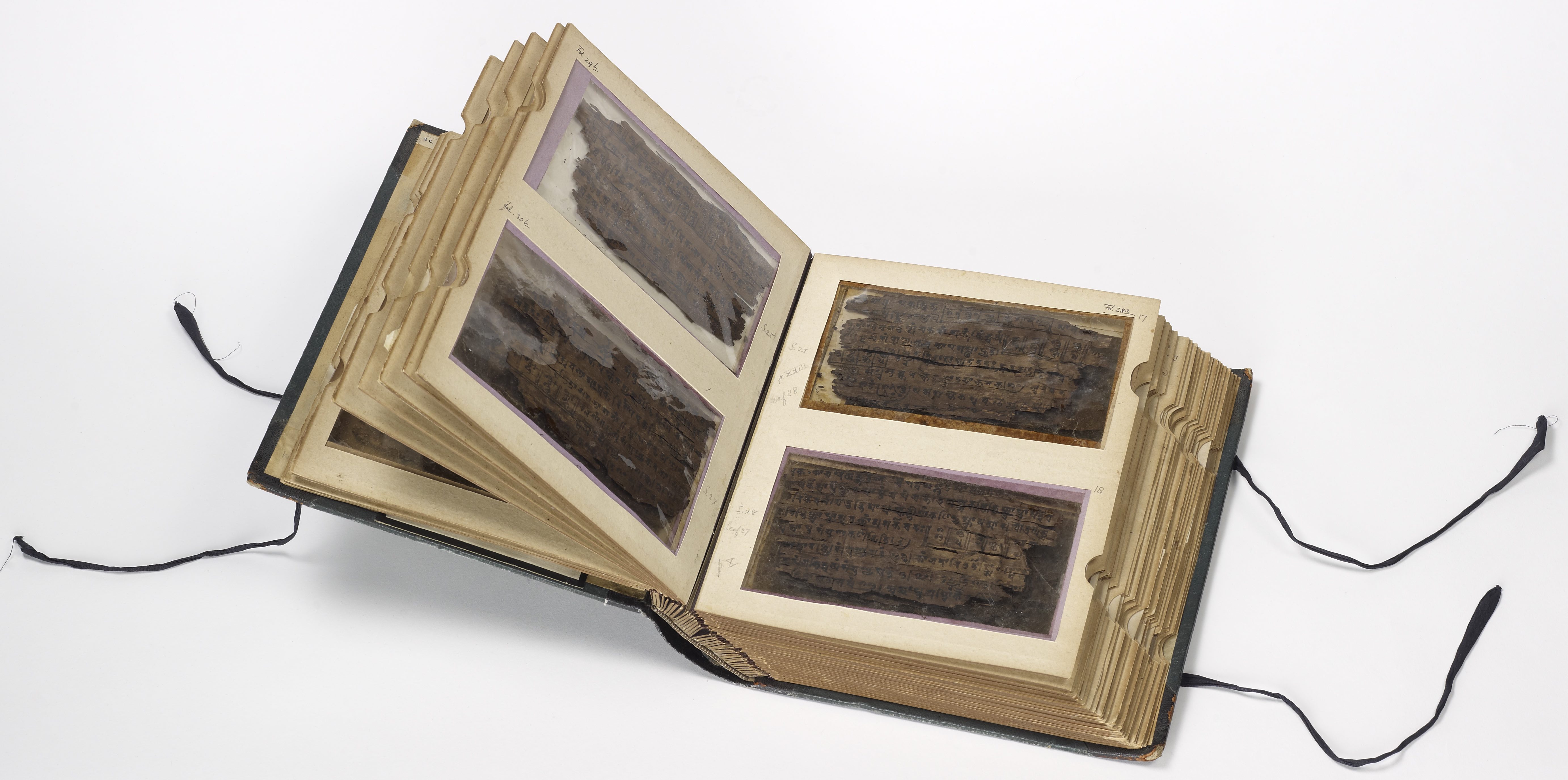
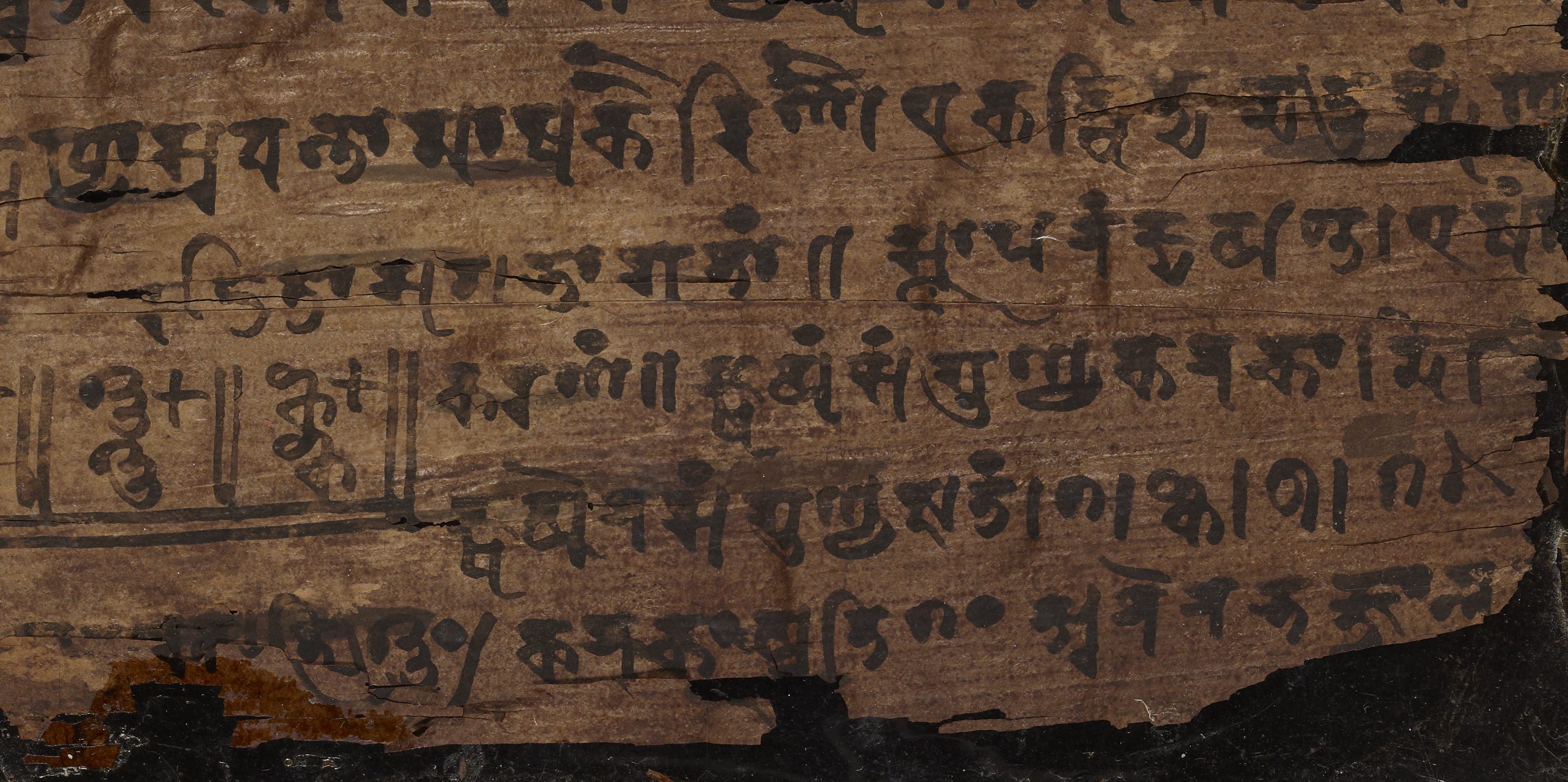
The Bakhshali Manuscript in its specially designed mounts which allow examination of the folios; detail of folio 16. Copyright: Bodleian Libraries, University of Oxford.
The date of the Bakhshali manuscript has been much debated since its discovery, with suggestions going as early as the third century and as late as the twelfth. In recent years a consensus emerged that it should be placed approximately in the eight century AD if not very considerably later – in any case not significantly earlier than the Gwalior inscription.
The fragile condition of the manuscript meant that it was not displayed and until now and there has been no systematic analysis of the sheaf of birch-bark as an object. But this was undertaken in early 2017 by the Bodleian's Heritage Science team and archaeological scientists at Oxford. Three samples of the manuscript were sent to the Radiocarbon Accelerator Unit in the School of Archaeology at Oxford. Two of the results were compatible with the general academic opinion about the text, pointing to dates in the periods AD 680-779 and AD 885-993. The third sample, however (from folio 16) brought an extraordinary surprise. It yielded the much earlier date range of AD 224-383. The results show that, contrary to what had always been assumed, the 'book' is a composite of texts written at at least three different times, which helps to explain past disagreements about dating based on its content and writing style.
Radiocarbon dates establish the age of organic material by measuring the presence of radioactive carbon isotopes, which decay at a known rate. Various factors complicate the calculation, so steps need to be taken to calibrate the results and reduce the risk of errors. Even so, it does not produce precise dates in the way that, for example, dendrochronology (tree-ring dating) can do. The science is exact but the results are not. Consequently, the date range should not be taken to mean, say, AD 224. Where the real date falls within the spectrum is a matter of probability.
Nevertheless, the new study's dating of the manuscript to the third or fourth century is hugely significant, and not only because it pushes the 'invention' of zero back hundred years earlier than believed. It also roots such knowledge and the mathematical interests exhibited by the text in the world of ancient Gandhara.
It was already clear that the manuscript originated at the heart of the region that had been Gandhara. But now we can imagine the earliest part of the text being written within the same society that produced the Gandharan monuments and sculptures – not necessarily, but possibly, within the community of Buddhists in the area. As the Bodleian's Sanskrit Librarian Camillo Formigatti has commented to the press, 'The content of the Bakhshali manuscript is similar to the type of texts that Buddhist merchants would have needed to study (and possibly use as reference) for their daily trading activities. It includes very practical mathematical examples and equations, such as how to compute the loss in weight of a quantity of impure metal in the process of refining it.' Regardless of who used it, the older parts of the text reflect the broader culture and society that gave rise to the more durable remains of Gandharan civilization.
It perhaps takes an effort of imagination to make that connection. In the study of ancient Asia, just as in Western classical studies, texts have often been taken out of their contexts, divorced from their physical medium. This is often true even of inscriptions in stone. In this case the very fragile nature of the text has limired the potential for handling. In disembodied form, important texts like this one take on a virtual life, reproduced in critical editions and academic discussions. It is, after all, one of the distinctive qualities of any kind of literature that it is not confined to a single set of pages. But nowadays, notwithstanding our increasing reliance on digital technology, we are more willing to emphasize the materiality of texts as well and to learn what we can about books as archaeological objects.
If we return to the circumstances of its discovery, we get a clearer impression of the Bakhshali manuscript as an archaeological discovery, coming literally out of the stones of Gandhara. The fullest account was provided by the then Assistant Commissioner (the civil servant in charge) at Mardan, whose letter of 5th July 1881 is quoted by Kaye (the officer is not identified).
3 It recounts how several weeks earlier a tenant farmer found the manuscript while digging for stones 'in a ruined enclosure on one of the mounds near Bakhshali'. What were taken to be the ruins of a village (he is open-minded about their date) lay 'on the west side of the Mardan and Bakhshali roads'. The man had also found a
diwa – a soap-stone pencil – and 'a large lota [water jar] of baked clay with a perforated bottom'. A search instigated by the Assistant Commissioner found nothing else. The farmer gave the manuscript to his landlord, an Inspector of Police named as Mian An-Wan-Udin, who handed it over to the Assistant Commissioner. He intended to despatch it to the Lahore Museum to arrange proper study, but in the event it went to the Lieutenant Governor of the Punjab, who then sent it on the advice of Alexander Cunningham (Director General of the Archaeological Survey of India) to the Indologist AF Rudolf Hoernle, then head of the Calcutta Madrasa, who gave it to the Bodleian in Oxford in 1902. Kaye also records the information in a letter from Cunningham to Hoernle in 1882 that the field where the manuscript was found had no (modern) building, and that the find occurred near a well.
This tantalizing account brings us no closer to understanding the precise context in which the manuscript was preserved (only to start disintegrating when handled!), but it vividly places the find within the archaeological landscape of Gandhara, at a time when British imperial officials were used to receiving, and hunting for, finds of 'Graeco-Buddhist' antiquities from the fields of the Peshawar Basin. The great monastic site of Jamal Garhi is only 9 km away; Takht-i-Bahi and Sahri Bahlol not very much further to the west. The new discovery at Oxford now locates the Bakhshali manuscript not merely in this geographical area, but in the period of its Buddhist heyday.
A folio from the Bakhshali manuscript will go on public display at the Science Museum in London as a centrepiece of the major exhibition
Illuminating India: 5000 Years of Science and Innovation, opening 4 October 2017.
[Peter Stewart 14/9/17]
*I am indebted to the Bodleian Libraries for detailed information about the manuscript and its analysis, including explanations by Prof Marcus du Sautoy and other colleagues. An academic publication is being prepared by the Oxford Radiocarbon Accelerator Unit. The most recent comprehensive study is Takao Hayashi,
The Bakhshali Manuscript: An Ancient Indian Mathematical Treatise (Leiden, 1995). See also the same author's overview with some key bibliography in H. Selin (ed.),
Encyclopaedia of the History of Science, Technology, and Medicine in Non-Western Cultures (1997), 147-8, s.v. Balkshali Manuscript. The manuscript is catalogued as Bodleian Library MS. Sansk. d. 14.
[1] See for example (all 14th September, 2017):
The Guardian;
BBC News online;
New Scientist. An
Oxford University video introduces the importance of the manuscript for the history of mathematics (last checked 14 September, 2017).
[2] First presented by A.F.R. Hoernle, with information on provenance, at the Asiatic Society of Bengal, 2nd August 1882; report in
The Indian Antiquary 12 (1883), 89-90. Hoernle reported that 'by far the largest portion' of the manuscript crumbled away when it was found.
[3] G.R. Kaye's,
The Bakhshali Manuscript: A Study in Mediaeval Mathematics (Calcutta, 1927), 1-2 on the discovery, with critical comment on the sources. Kaye's scepticism about the mention of ruins does not seem justified, given the Assistant Commissioner's familiarity with the site and very proper caution about the oral report of its findspot.
Posted by Peter Stewart, CARC at 17:54
Posted by Peter Stewart, CARC on 15/09/2017 at 10:34
Without wishing to undermine my argument, just one caveat for this blog post: it is possible, in principle, that the earliest part of the manuscript so far identified - the portion that dates to the third or fourth century AD - was written elsewhere, albeit it in the same general region (based on internal evidence). We could imagine it being combined with the other folios eventually by, say, the tenth century and only after that did the composite book end up in the place it was discovered, near Mardan. Naturally what the farmer at Bakhshali discovered was the book at the end of its ancient life - in its final form then lost or abandoned, long after the period of Gandharan culture. If the book's components had travelled, we should not imagine that it was literally being written e.g. in the shadow of Jamal Garhi in the Heyday of Buddhist Gandhara! That said, the likelihood that the manuscript has its origins in that specific area, i.e. in third/fourth century Gandhara, remains high.
Thursday, 27 April 2017
Chronological problems
Gandhara Connections Project Assistant Kay Rienjang reports on the recent workshop, 'Problems of Chronology in Gandharan art: Our first Gandhara Connections workshop began with the long-standing question at the heart of studies in Gandharan art and culture: how to make sense of its chronology. The successful workshop gathered international specialists in different areas of Gandharan studies to pull out ideas and engage in the interdisciplinary discussion. Our lecture room was bustling on both days of the event, and thanks to the live-stream webcasts, those who could not physically join us could follow the presentations and engage in real-time discussion remotely. We were delighted to be joined 'virtually' by viewers abroad, including a group of researchers on the Chinese project 'Hellenistic Civilization and the Silk Road', who watched from Nankai University in Tianjin.
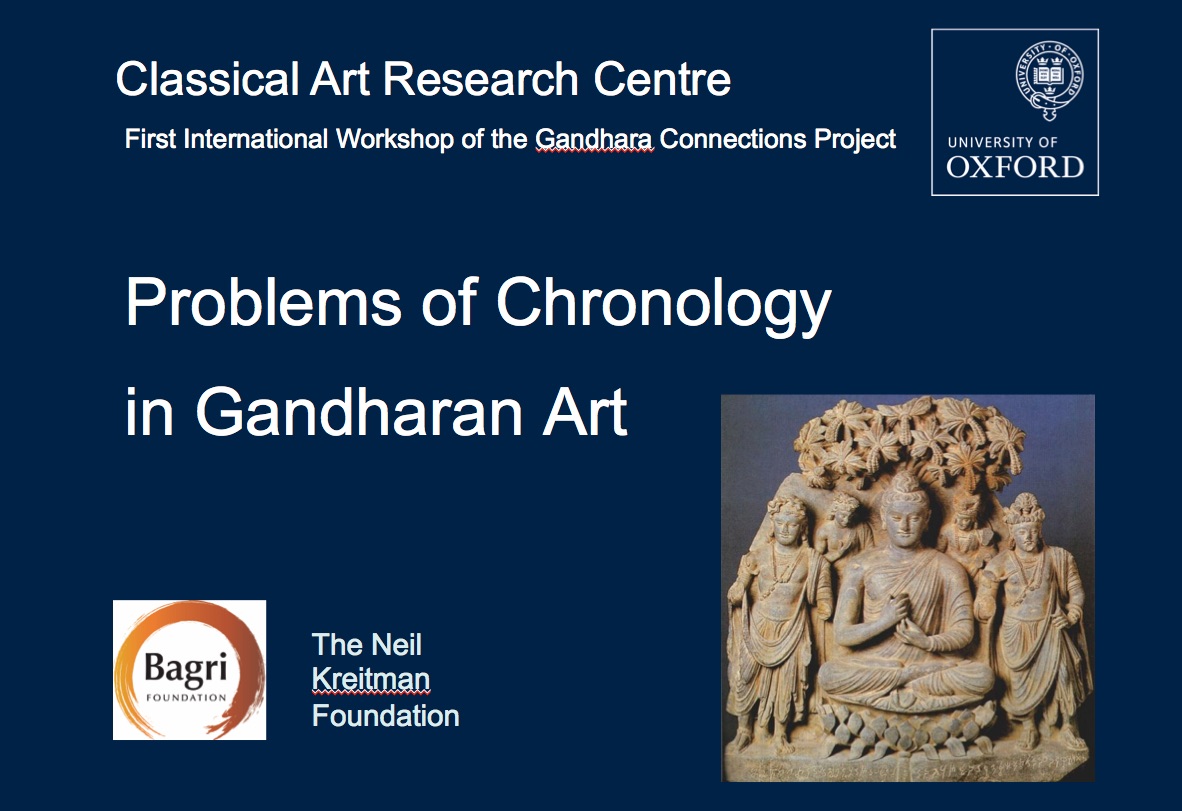
The workshop started with a talk by Joe Cribb (formerly Keeper of Coins and Medals at the British Museum), who reviewed the numismatic evidence to strengthen Harry Falk’s proposal that the Kushan ruler Kanishka I’s first year started in AD127. Although still opened to debate, this affirmation is the result of detailed and systematic analysis of numismatic evidence, in combination with epigraphic sources and Falk’s astrological reasoning. A wealth of specific and circumstantial evidence now supports this date, which has important ramifications for Gandharan art. This numismatic presentation was followed by an art-historical talk by Monica Zin (Saxon Academy of Sciences), who drew attention to the artistic similarities and differences between Gandharan and Andhra art in India and the possible chronology that these artistic relationships may suggest.
The afternoon session started with exciting archaeological contributions. Our Pakistani colleague, Abdul Samad (Director of Archaeology & Museums for Khyber Pakhtunkhwa), presented recent archaeological work employing modern methods in the province, and particularly fieldwork at the Buddhist site of Bhamala at Taxila. The C-14 dating of the wooden cores inside some terracotta sculptures from this site provide a date of mid third to early fifth century AD to add to the chronology of the site. Our Italian colleagues, Anna Filigenzi (L’Orientale, Naples) and Luca Olivieri (Italian Archaeological Mission in Pakistan) gave a paper (read by Peter Stewart) on their discoveries at the urban site of Barikot, and two nearby Buddhist complexes, Gumbat and Amluk-Dara in Swat. The artefacts unearthed from these stratified sites potentially provide benchmarks for the chronology of certain types of Gandharan art. This presentation also highlighted the main change that occurred at the Buddhist complex of Butkara I, also in Swat, during the third century AD in the taste, techniques and materials of the buildings and their associated sculptures.
Our last presentation of the first day was by Ciro lo Muzio (La Sapienza, Rome), who examined one of the most fascinating types of Gandharan art: toilet trays. Lo Muzio drew attention to the similarities in form, ornament and iconography between Gandharan toilet trays and some architectural sculptures on some of the earliest Buddhist monuments in India. His observation proposes the possible chronological correlation between the two artistic traditions if the re-assessment of the Sunga period, a period generally assigned to a large part of the early Indian monuments, to the first century AD is correct.
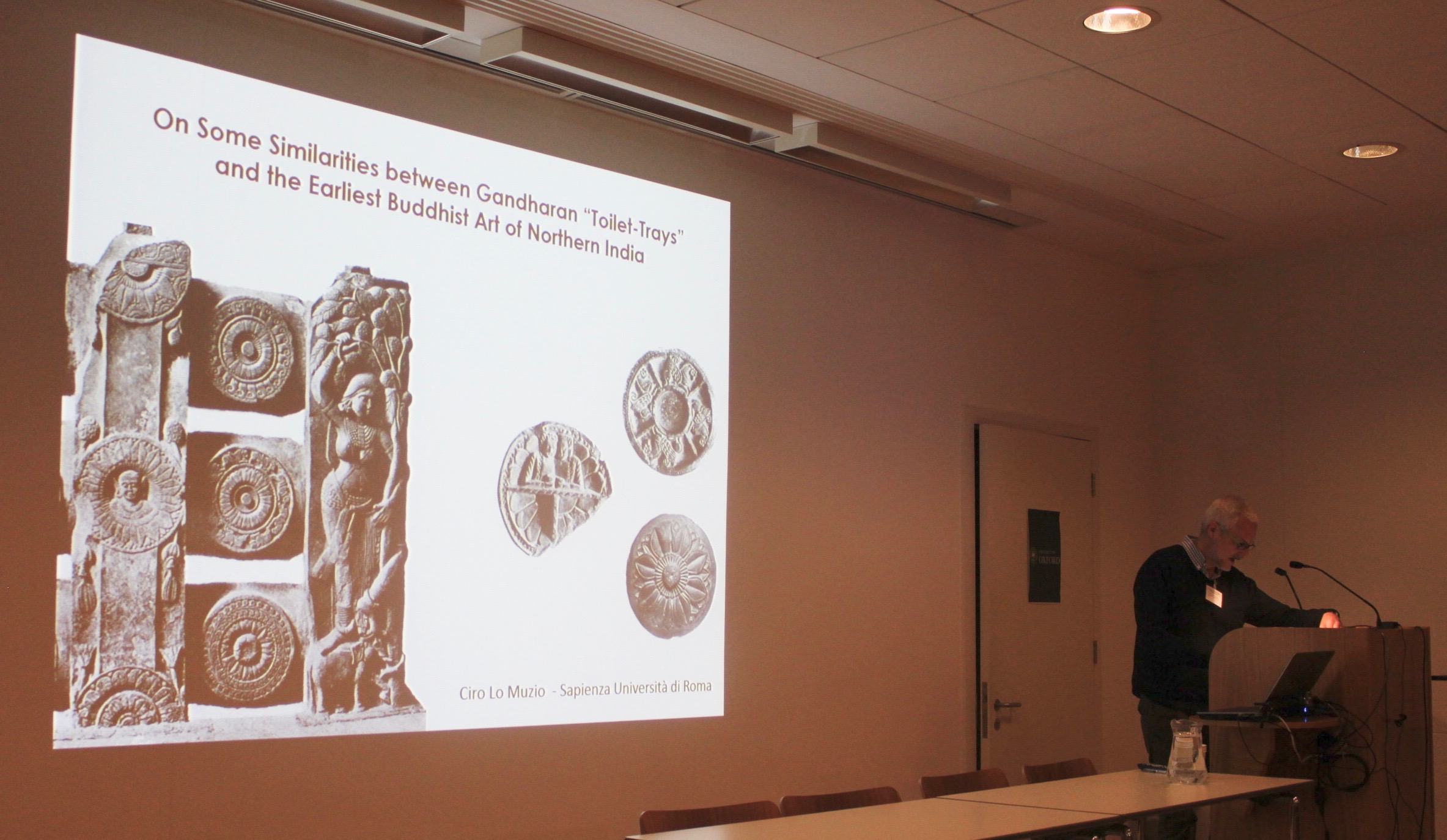
Ciro Lo Muzio talks about Gandharan toilet trays and their connections with Indian elements
The second day started off with an examination of stupa relic deposits in eastern Afghanistan and Dharmarajika Pakistan by Wannaporn Kay Rienjang (CARC). Rienjang presented the changing nature of stupa deposits through time and the possible decline in stupa relic deposit that may have coincided with the rise of popularity in the image cult during the period of the late Kushan. The next presentation was by a notable Gandharan epigraphist, Stefan Baums (Ludwig-Maximilians Universität München), who used his expertise to illustrate different methods for dealing with inscriptions found on various media of Gandharan art, and how they can help with the dating of these objects on which they were inscribed.
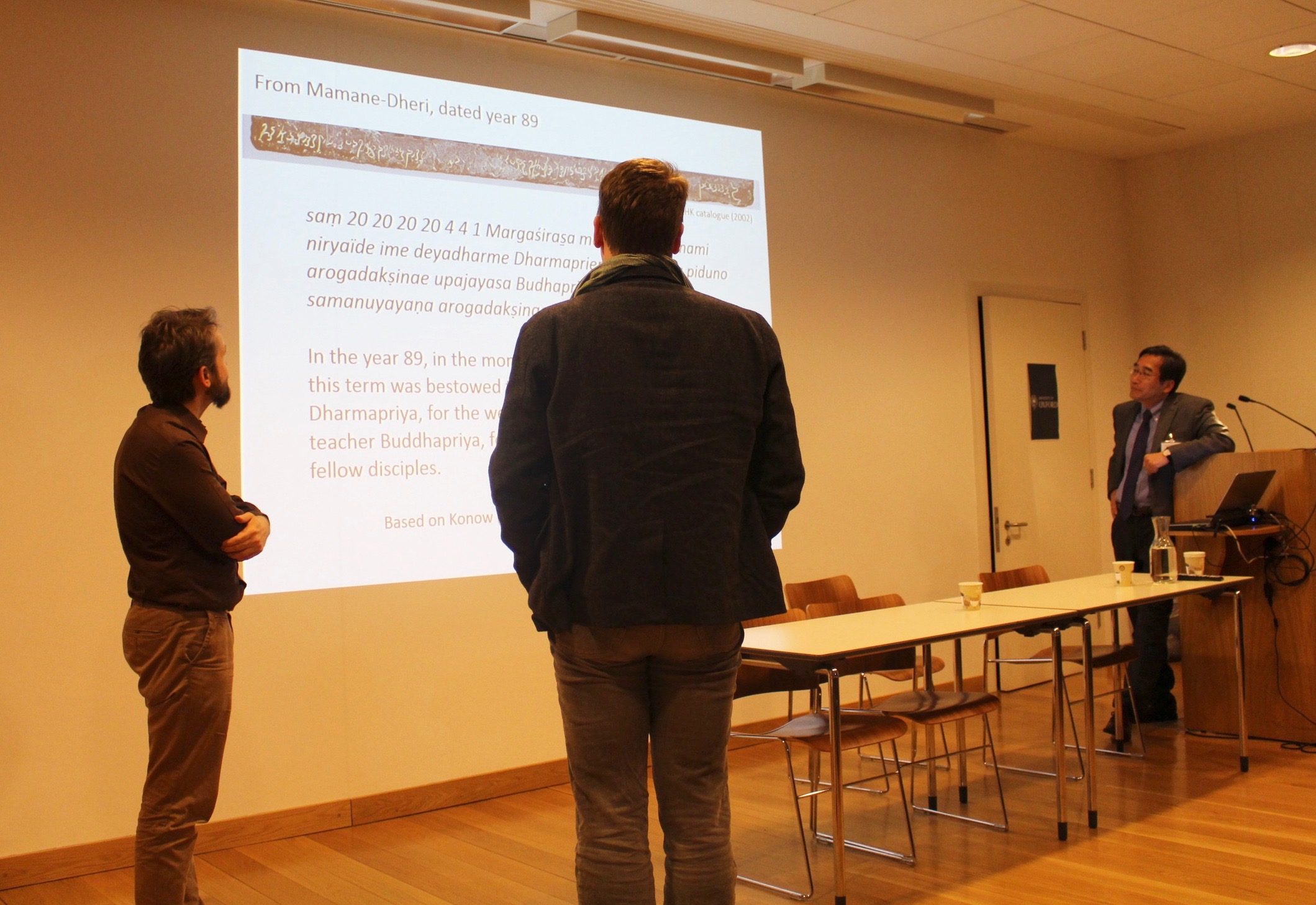
Engaging with epigraphy: Stefan Baums, Robert Bracey and Juhyung Rhi contemplating a date inscription on a work from Mamane-Dheri
Our afternoon session was resumed by Robert Bracey (British Museum). Bracey reminded us of the complexity involved in reaching a date for an Indian work of art related to the classical tradition. His example, an enigmatic Mathuran sculpture in the Cleveland Museum that incorporates classical, Indian, and Gandharan elements, poses many questions not only in respect to its date, but also its origin and authenticity. Complexity in the chronology of Gandharan art was explored further by Juhyung Rhi (Seoul National University), who examined the very limited numbers of dated Gandharan sculptures and related them to the boarder picture of chronology of Gandharan art. Like Robert Bracey, Rhi reminded us that the complexity does not only lie in the dates inscribed on these sculptures and the eras they belong to, but in many other interpetative problems. One of these is the diversity of workshops in different regions of Gandhara whose artistic traditions may have undergone different phases of developments although within the same timeframe.
Our workshop ended with Kurt Behrendt (The Metropolitan Museum of Art), who reviewed some aspects of important Gandharan sculptures known from particular sites, including their materials, sizes, iconography, and their re-contextualization. He examined these aspects in relation to those of the late sculptures from India and Central Asia, proposing that a large number of Gandharan sculptures actually belong to the ‘later’ phases of Gandharan chronology.
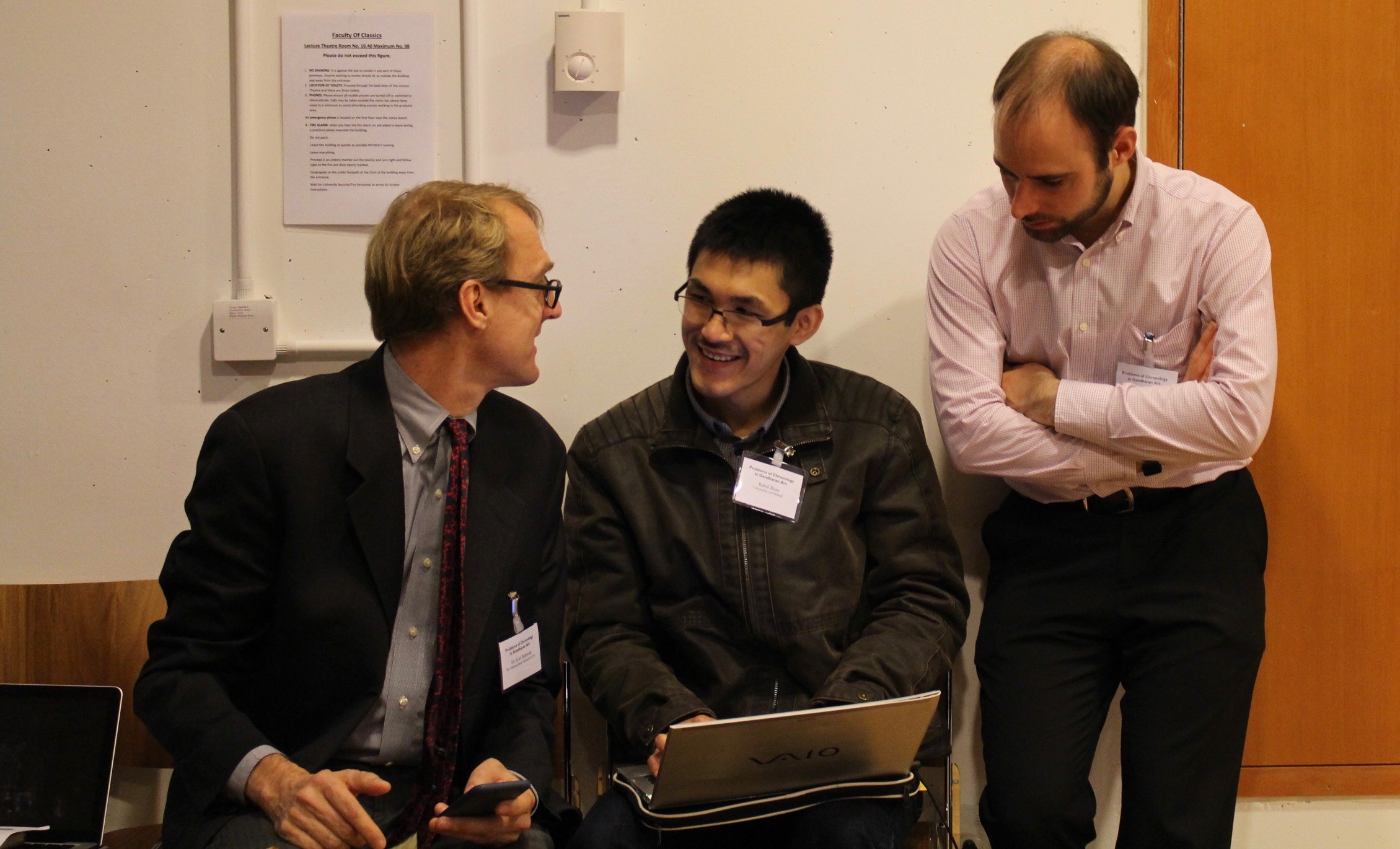
Our speaker, Kurt Behrendt and our team member, Giles Richardson, discussing live-streaming with our volunteer, Rahul Raza, who monitored comments and questions from remote viewers
Chronology, of course, remains a challenging topic. However, rather than contradicting each other, the complementary papers presented in this workshop highlighted a growing consensus both about the dating of Gandharan art and about new questions and problems that arise as we refine our understansing of chronology. Key issues were isolated and the thought-provoking presentations suggested ways forward for further multidisciplinary research on Gandharan art. The foundation was also laid for our second workshop, which is to come in a year's time, ‘The Geography of Gandharan Art’.
Thank you again to all the contributors and the audience in Oxford, as well as our remote audience from different parts of the world (including Afghanistan, Pakistan, India, China, Thailand, Japan, the United States, and Canada). Don’t miss the publication of our workshop proceedings which will be freely available online by early next year. We look forward to seeing you again in 2018!

Posted by Guest Database User at 10:20
Friday, 24 February 2017
The Pyxis-cum-Reliquary
Formal, stylistic and technological similarities in the material cultures from different places often form the basis for the reconstruction of the ‘connections’ between those cultures. In greater Gandhara, an area encompassing parts of today’s eastern Afghanistan as well as northern Pakistan, a certain type of lidded container in a cylindrical form is reminiscent of the Graeco-Roman pyxis, a type of box used over the centuries to hold cosmetics, trinkets or jewelry (a relatively early example is below).
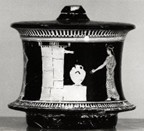
Greek (Attic) pyxis, ca. 500-470 BC (BM1873,0111.6). Courtesy of the Trustees of the British Museum
Many of these pyxis-like containers found their ways into the Buddhist ritual activity of relic worship in greater Gandhara, serving as Buddhist reliquaries. These pyxis-like reliquaries are peculiar to this region, particularly during the first to second centuries AD. A number of them were reported from stupa deposits in eastern Afghanistan, Swat and Taxila.
1 Although the form and style are similar to the Greek and Roman pyxides, which are commonly made of terracotta, marble and precious and semi-precious metal, the Gandharan pyxis-like reliquaries are made of schist and steatite, a medium-grade metamorphic rock locally available in Afghanistan and Pakistan.
2
Were these pyxis-like reliquaries originally made as cosmetics boxes before entering the relic deposits? There are a small number of pyxis-like vessels that are made of bronze and copper found in the settlement area of Sirkap at Taxila.
3 Unlike stone pyxis-like reliquaries, none of these metal pyxides were found in stupa deposits, and so any of these metal vessels may have served as cosmetic boxes. There is, however, one unique bronze pyxis-like vessel from the Peshawar valley that was found inside a stupa deposit.
4 This unique vessel has a cylindrical body like that of a pyxis, and its lid was topped with three religious figures (Buddha, Indra and Brahma).
5
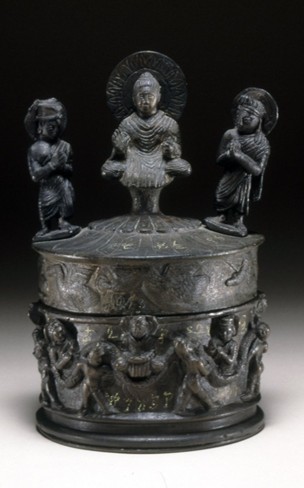
Replica of the Kanishka casket. BM1880.270. Courtesy of the Trustees of the British Museum
This bronze reliquary is unique in that it is the only pyxis-like reliquary made of metal to have been found in a relic deposit, and it is one of the only two known Gandharan reliquaries to depict anthropomorphic figures. Although it is not clear if this bronze reliquary was previously used before being deposited, the inscription on its lid refers to it as an incense box.
6 Unfortunately, there is no evidence for the stone pyxis-like reliquaries that might tell us about their previous use prior to being used as reliquaries.
However, the idea that it might be 'appropriate' to use containers for cosmetics or similar substances to hold the bones of the Buddha and Buddhist monks is nothing new.
7 We also have some examples of such Gandharan reliquaries which not only held corporeal remains but also ornaments such as beads and earrings. An example is a pyxis-like reliquary from Afghanistan that was found in stupa deposits of Kotpur stupa 2.
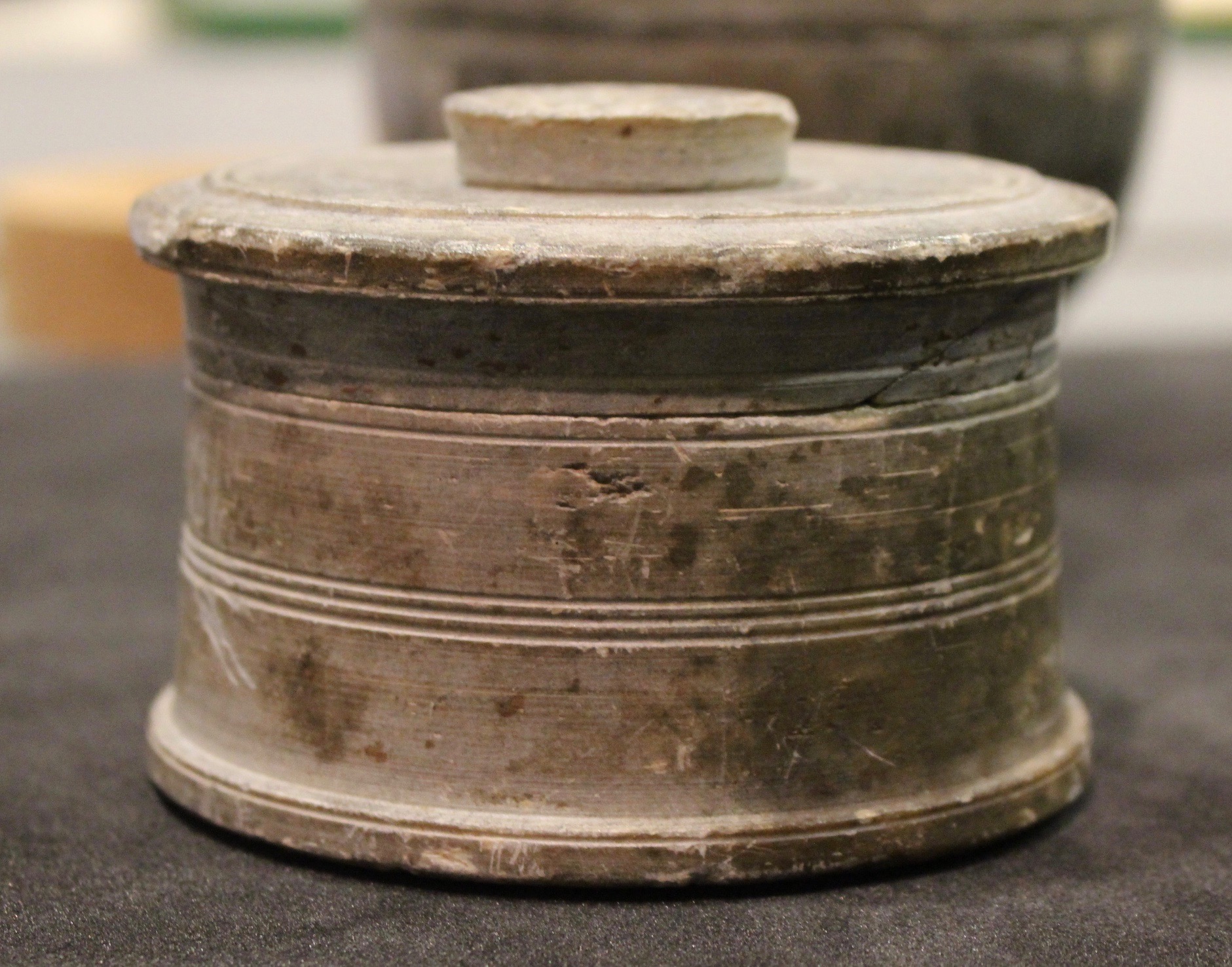
Pyxis-shaped reliquary from Kotpur stupa no. 2 in eastern Afghanistan (BM1880.96). Photo ©Wannaporn Rienjang. Courtesy of the Trustees of the British Museum
This box held another smaller reliquary of silver, which contained ashes, two gold ornaments and a gold bead.
8 In this respect, it is not surprising to find a number of pyxis-like reliquaries in stupa deposits; their function of holding something precious and of ornamental nature continued into the religious sphere.
Most of these pyxis-like reliquaries can be dated around the first and second centuries AD. By this time, some non-Gandharan pyxides may have made their way to Gandhara by means of trade or well-off travellers. These elite travellers could even have been political figures or members of diplomatic delegations, who brought with them their own personal objects. Imported objects like the luxury pyxides, could have attracted the interest of local inhabitants. The Gandharan craftsmen used the locally available schist and steatite to produce the vessels, adapting the forms of the imported pyxides to suit the taste of their local buyers. It seems as though the inhabitants of greater Gandhara preferred the decoration of their pyxides to be non-narrative, as opposed to the various Greek and Roman pyxides whose bodies are often decorated with stories. However, some decorative motifs such as the chevron design are shared between the local and non-local pyxides. An example of the shared chevron design can be seen on a marble pyxis of the Roman period from Aegina, now in the British Museum, and a schist reliquary from Sirkap, Taxila.
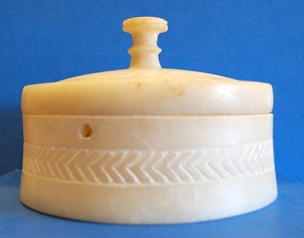
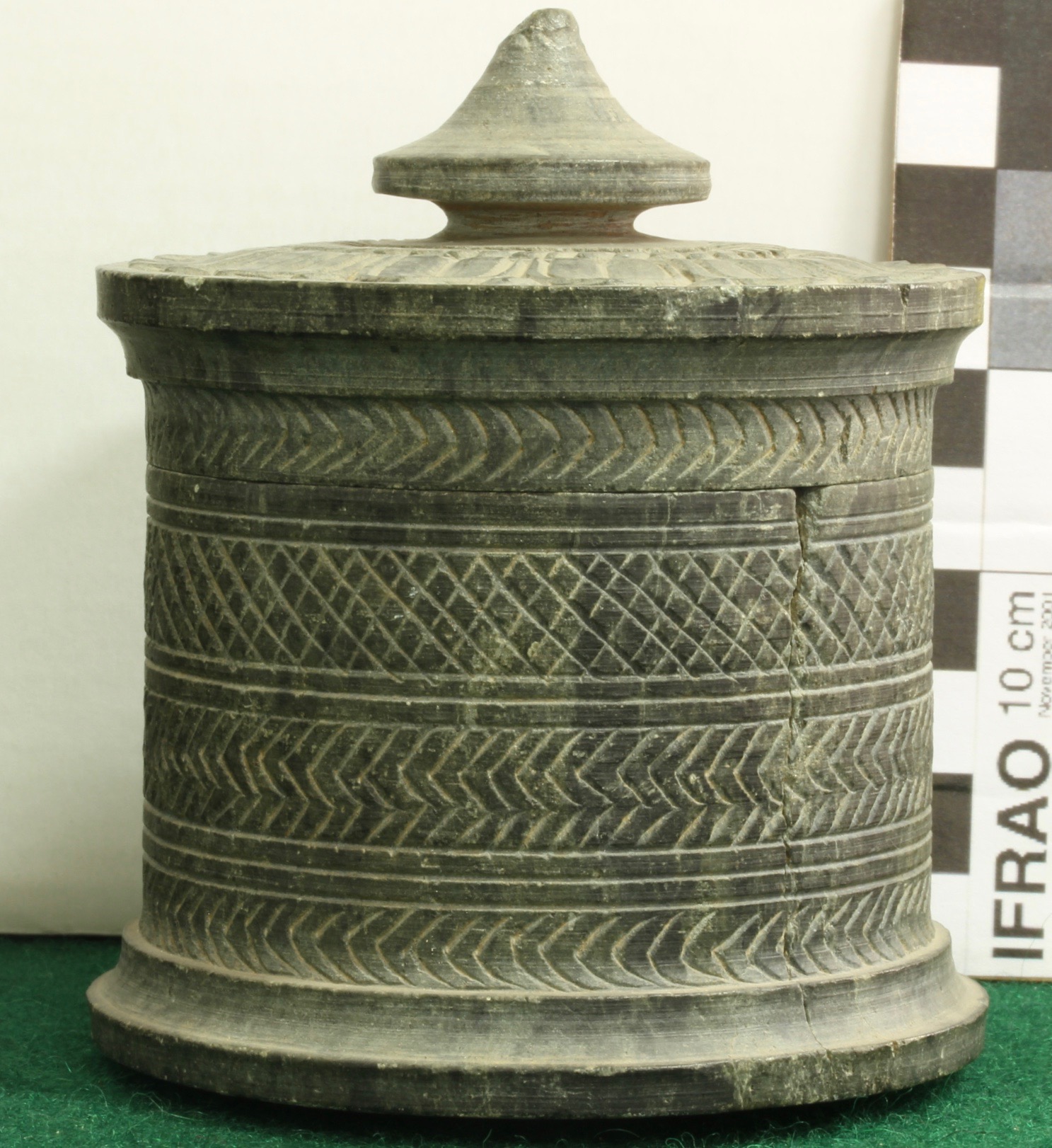
Left: Roman pyxis from Aegina (BM1893,0712.4). Courtesy of the Trustees of the British Museum.
Right: Pyxis-shaped reliquary from Sirkap, Taxila (TM8586, Sk.1479-24). Photo ©Wannaporn Rienjang. Courtesy of the Taxila Museum.
This Sirkap reliquary is also similar in form to a Hellenistic bronze pyxis in the British Museum (below). The non-figural character of most Gandharan pyxides, the shared motifs, and the retention of non-Gandharan forms and styles may demonstrate a two-way interaction rather than simple one-way influence or the wholesale importation of foreign ideas. But who was involved in this sort of interaction? Pyxides are very portable and can travel easily. Did such finely crafted and valued objects really move around with foreign elite owners, with diplomatic visitors, or simply through luxury commerce? Were immigrant craftsmen involved in the dissemination of forms? Were they involved in training the local craftsmen to produce such objects? These are the questions that need further investigation, but answers will entail more evidence from the detailed documentation of the future excavations. [Wannaporn Kay Rienjang 24/2/17]
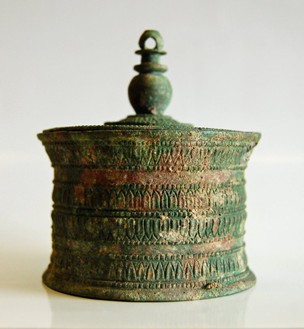
Hellenistic pyxis (BM1873,0820.127). Courtesy of the Trustees of the British Museum.
[1] For a comprehensive list of reliquaries with their provenance see D. Jongeward, E. Errington, R. Salomon and S. Baums,
Gandharan Buddhist Reliquaries (Seattle, 2012), 254-295.
[2] For sources of these types of stone in Afghanistan, see Sh. Abdullah and V.M. Chmyriov,
Geology and mineral resources of Afghanistan (2008), 41-42. For Pakistan, see R. Law,
A Geologic provenience study of Harappa’s rocks and mineral assemblage (Kyoto, 2011), 67-72.
[3] J. Marshall,
Taxila: an illustrated account of archaeological excavations carried out at Taxila under the orders of the government of India between the years 1913 and 1934 (Cambridge, 1951), 587-88, Pl. 171, r, u.
[4] D.B. Spooner, ‘Excavations at Shāh-jī-kī-Dherī’,
Archaeological Survey of India Annual Report (1908-9), 49-53.
[5] For a detailed description of this reliquary see N. Kreitman, ‘Replica of the ‘Kanishka’s casket’,
The Crossroads of Asia. Transformation in image and symbol (Cambridge, 1992), 193-97.
[6] S. Baums, ‘Catalog and revised texts and translations of Gandharan reliquary inscriptions’,
Gandharan Buddhist Reliquaries (Seattle, 2012), 246, no. 45.
[7] M. Willis,
Buddhist reliquaries from ancient India (London, 2000), 12-26.
[8] H. Wilson,
Ariana Antiqua: a descriptive account of the antiquities and coins of Afghanistan with a memoir on Posted by Peter Stewart, CARC at 21:33
Friday, 27 January 2017
A well near Hund...
Peter Stewart writes "Lack of archaeological provenance is one of the most serious obstacles facing the study of Gandharan art. Even excavated works often derive from old and poorly documented excavations. But the majority of Gandharan sculptures in museums or private hands today did not come from systematic excavations. Now as in the past objects emerge as a result of undocumented, casual discoveries while, of course, deliberate looting is a huge and endemic problem.
Against this background we are used to dealing with sculptures whose origins are obscure. Even the information offered by an approximate provenance is frequently lacking. Consequently the famous 'Trojan Horse' relief in the British Museum is an extraordinary exception because of the proliferation of conflicting accounts that have survived about its origin.
1 There is perhaps no other Gandharan sculpture that has been as frequently illustrated and mentioned in print than this peculiar relief. Its Gandharan origin is not in doubt. From its shape we can assume that it was used as a stair-riser on a Buddhist stupa. But the scene represented on it appears, at least superficially, to be very foreign to conventional Buddhist imagery. It represents an artificial horse on a trolley being conducted forwards towards a gateway by two men (a third one, fragmentary, watches). Its passage is blocked by a a man in a classical-style tunic and cloak who thrusts a spear into its chest. Behind him a half-naked female resembling a
yak?i (or some suggest a city-goddess, a
nagaradevata) throws up her arms in alarm.

Photo copyright the Trustees of the British Museum.
Aside from her, the figures, their clothes and poses, their naturalistic forms, are highly reminiscent of Graeco-Roman sculpture. There is nothing unusual about that (the Gandharan adoption of classical forms is the starting-point for the Gandhara Connections project). What
is more unusual is that the scene has been taken wholesale from classical myth and indeed from classical iconography, for it closely follows at least a couple Roman-period representations. To the eyes of a classicist this is a representation of the Trojan Horse. The spear-man is the priest Laocoon, who realizes that the horse is a trick (being used to smuggle Greek warriors inside the walls of the besieged city of Troy). The woman is the prophetic princess Cassandra, who foresees the disaster. We cannot fully understand why this scene might have appealed in a Buddhist context; only one other example is known (a small and crude scene with rather different imagery). Perhaps the best hypothesis was advanced many years ago by Alfred Foucher, who proposed that the Trojan story had been appropriated and adapted as a
jataka – a past life story of the Buddha – and that the 'Laocoon' was in fact the bodhisattva himself, the future Buddha, saving the day by defying the enemy's ruse.
2
The relief was acquired in the 1920s by an Indian Civil Servant on the North-West Frontier, Francis Wylie (later Sir Francis). It was published soon afterwards and for decades scholars studied it through the photograph taken at that time for Henry Hargreaves' brief note on it.
3 In 1990 Wylie's son sold it to the British Museum, cementing the sculpture's fame. However, no fewer than four contradictory accounts existed as to what part of Gandhara it had come from. These were analysed by Wladimir Zwalf when he was preparing his magisterial catalogue of the British Museum's Gandharan collection.
4 Firstly, the original publication assumed that the relief had been found in the vicinity of Mardan. Secondly, another former civil servant, Sir Olaf Caroe, reportedly claimed in a lecture of 1976 that it had been found in the Swabi Tahsil, specifically near Hund on the River Indus – that is, more than 40 km to the south-east of Mardan. Thirdly, Sir Mortimer Wheeler stated repeatedly in the 1960s (after he had worked in Pakistan) that the relief had reportedly been found at Charsadda, further to the west. Finally, and most intriguingly, Verner Wylie believed that the sculpture had been given to his father by grateful parents, whose child Wylie had apparently rescued from a well around 1920 – but at Chitral, very far to the north of the Peshawar basin, the heartland of ancient Gandhara...
In an article in the latest volume of
Arts Asiatiques, I revisit the evidence for these stories in an attempt to cast further light on this important sculpture's origins.
5 And it transpires that Sir Olaf Caroe's claim is crucial. He did indeed mention the relief in his 1976 lecture to the Tibet Society of London, but it was no casual reference. He appears to have had the relief with him in the room, presumably lent by the Wylie family, and he illustrates a sculpture that he himself had owned, a small fragment representing a bodhisattva, which he says he had
also picked up near Hund during his period of service on the North-West frontier. More of Caroe's information is hiding in plain sight. His 1958 book on
The Pathans – a highly regarded work but not immediately obvious reading for archaeologists – mentions the Trojan Horse relief in a footnote, with the matter-of-fact comment that it was 'discovered on a well near Hund' in 1923.
6
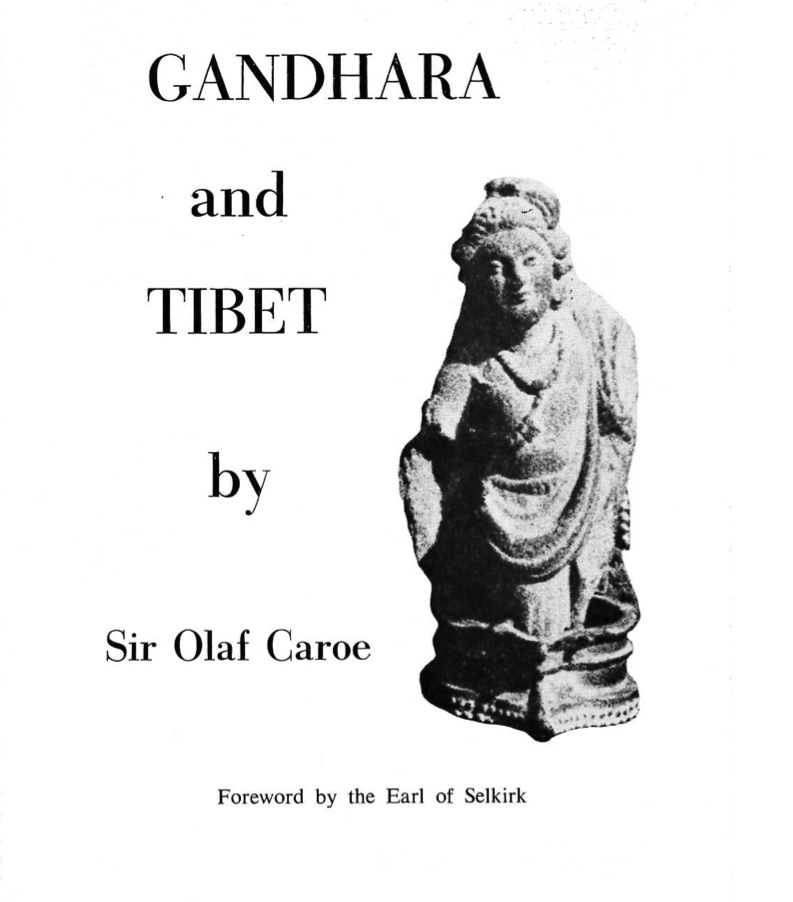
Caroe's lecture to the Tibet Society in 1976. Scan of cover from version printed for small-scale circulation (courtesy of the Tibet Society).
Archival evidence, including Wylie's Indian Civil Service files and Sir Olaf Caroe's unpublished autobiography help to substantiate some of the detail, making it likely that Wylie acquired the relief between April and July 1923, when he was Assistant Commissioner at Mardan. He, like Caroe and other holders of the post, would have become intimate with the area of Hund and some of the leading families in the area. It is also clear from the documents that Wylie and Caroe were not only colleagues but intimate friends, both former classics students (in Dublin and Oxford respectively) who, in Caroe's words, 'spoke the same sort of language based in the classics, and enjoyed a rather mocking, mutual badinage over the different angles of vision from Dublin and Oxford. We also loved roaming the hills and valleys of the Frontier together. We would quote Kipling’s Jobson to one another... '
7
What of the well near Hund? The location is not surprising, perhaps, for although little Gandharan sculpture is reported in the area, there is abundant evidence of unexplored remains from different periods, as well as extensive looting.
8 That the 'Trojan Horse' relief was 'on a well' there implies that it had been built into the structure, having been found locally, although it could have come from further afield. Perhaps Caroe's piece had also formed part of the same structure. In any case, they provide a hint of the archaeology of the village which may yet have valuable information to yield." [27/1/17]
[1] British Museum, OA 1990.10-13.1. Height: 16.2 cm. Full references are given in my article and in Zwalf's catalogue (as cited below). In studying the relief's history I was grateful to receive advice and help from a number of colleagues, the Tibet Society, and from the families of Francis Wylie and Olaf Caroe.
[2] A. Foucher, 'Le cheval de Troie au Gandhâra',
Comptes rendus des séances de l’Académie des Inscriptions et Belles-Lettres 94 (1950), 407–412.
[3] H. Hargreaves, 'Two Unidentified Reliefs from Gandhara',
Annual Report of the Archaeological Survey of India, 1923–1924 (Calcutta, 1926), 125–126.
[4] W. Zwalf,
Catalogue of the Gandha¯ra sculpture in the British Museum (London, 1996), pp. 233–234, no. 300.
[5] P. Stewart, 'The Provenance of the Gandharan "Trojan Horse" Relief in the British Museum',
Arts Asiatiques 71 (2016), 3-12. Full references for archival sources etc are in the article.
[6] O. Caroe,
The Pathans, 550 B.C.-A.D. 1957 (London, 1958), 444, n. 11.
[7] Archives in the British Library, London. See esp. British Library, IOR/R/1/4/1325 (Wylie's file); MSS. EUR. C.273/4 (Caroe's autobiography).
[8] See S.N. Khan, 'Report on the Archaeological Survey of Swabi District',
Ancient Pakistan 11 (1995), 75–174, esp. 90, 99-101; Z. Khan, M. Durrani, and M.M. Khan, 'A Note on the Archaeological Significance of Hund',
PUTAJ (Peshawar University Teachers’ Association Journals) Humanities and Social Sciences, 19 (2012), 77–87.
Posted by Peter Stewart, CARC at 12:09
Friday, 11 November 2016
Sir Mortimer, Magnus, and Marshall
We recently posted a link on Twitter to a series of archival TV recordings put online by the BBC. They are not viewable outside the UK, so they merit a blog post.
1 The 1974 recordings are interviews by the broadcaster Magnus Magnusson with the brilliant, flamboyant, and in certain respects controversial British archaeologist, Sir Mortimer Wheeler (1890-1976). Wheeler is especially associated with the archaeology of the Roman Empire and much of his famous work was on Roman Britain. But he had a global interest in the ancient world and had been Director of the Archaeological Survey of India between 1944 and 1948. After Partition, Wheeler served for two very productive years as an archaeological advisor to the government of Pakistan.
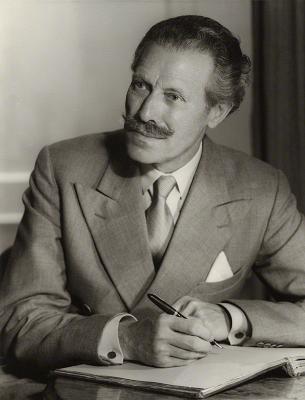
Photograph of Mortimer Wheeler in 1956, by Howard Coster (via Wikipedia
https://en.wikipedia.org/wiki/File:Robert_Mortimer_Wheeler_by_Howard_Coster.jpg [last consulted 10/11/16])
In 1958 Wheeler returned to Pakistan and during one season of excavations he explored the stratigraphy of the Bala Hisar mound at Charsadda, the site of the ancient city of Pushkalavati, and studied the nearby Shaikhan mound.
2 One of the BBC interviews deals with this period of Wheeler's work. With the sense for rather self-promotional drama that made him a popular television personality in the UK, Wheeler describes how Charsadda's Hellenistic Greek origins (as he saw them) first came into focus from the otherwise confused archaeological remains at Shaikhan Dheri:
'I had made arrangements beforehand with the Pakistan Airforce, to have an air photograph taken of the area I was going to deal with... a jet fighter swooped down over my head, almost took my hat off... The poor pilot had been instructed in Peshawar to go away and photograph the old city at Charsadda. Of course when he got there he realized there was no old city; he didn't realize the mounds were intended, and he didn't know what to do. So he received instructions on the telephone to photograph the area for half a mile or so around my tents, which he did. He took about a quarter of an hour altogether, swooping about there, and I thought "My God, nothing will happen here; after all, he's going to fast to begin with to get a decent photograph". But next morning a messenger came from Peshawar... with a bunch of photographs. And as I turned them over with my colleagues – I had two young men from Cambridge and other men from various parts of Pakistan – we looked through them and they shrugged their shoulders. And I said "What do you make of it?" They said, "It all looks rather... it's very nice but rather muddled." I said, "What do you make of that one?"... They looked again. They were not used to this sort of thing, or this sort of quiz. So I said, "Well, this is the greatest discovery made in the Frontier of Pakistan for perhaps a hundred years." And then I explained. What I saw in this air photograph was the plan of a large part of a Greek city.'

One of the aerial views of Shaikhan Dheri described in the BBC television interview.
The walls had been robbed out by farmers, leaving the trace of a classical-style grid-pattern in negative for the aerial photograph to detect, and in the midst of it the distinctive form of a Buddhist stupa. Not all Wheeler's conclusions proved accurate, and nowadays there is significant doubt about the inherent Greekness (or Roman-ness) of urban grid-plans.
3 But there is no question about the importance of the sites at Charsadda in this period and earlier, or the role that pioneering aerial photography had in illuminating them.
In the same interview, Wheeler tells an anecdote that should probably be taken with a large pinch of salt, about the 'accidental' appointment of a young John Marshall, later Sir John Marshall, as Director-General of Archaeology for India. He claims that Marshall happened to visit the then Director of the British Museum (Sir Edward Thompson) just when he was expecting a
different Marshall from the Museum's staff to be sent to him as a suggested nominee for the post. 'He said, "Well now, look here: they want a man in India to look after the Archaeological Survey there. How soon can you go?"' The rest is history.
[1] 'Sir Mortimer and Magnus', first broadcast 10th October, 1974
http://www.bbc.co.uk/iplayer/episode/p017fcbx/sir-mortimer-and-magnus-4-in-the-steps-of-alexander [last consulted 10/11/16].
[2] R.E.M. Wheeler,
Charsada: A Metropolis of the North-West Frontier (Oxford, 1962).
[3] See R. Mairs, 'The "Greek Grid-Plan" at Sirkap (Taxila) and the Question of Greek Influence in the North West', in M. Willis (ed.),
Migration, Trade and Peoples. European Association of South Asian Archaeologists, Proceedings of the Eighteenth Congress (London, 2005), Part 2 (ed. C. Fröhlich), 135-47. For overview of current knowledge about the sites at Charsadda see esp. C. Petrie, 'Charsadda', in D.K. Chakrabarti and M. Lal (eds.),
History of Ancient India III: The Texts, and Political History and Administration till c.200 BC (Delhi, 2013), 512-22.
Posted by Peter Stewart, CARC at 00:11
Wednesday, 26 October 2016
An Atlas at the Ashmolean
CARC's next-door neighbours at the Ashmolean Museum of Art and Archaeology at Oxford have recently made a stunning addition to the their important collection of Gandharan sculpture.
1 (The Gandharan collection as a whole is going to receive a fresh catalogue by David Jongeward in 2017.) The newly donated sculpture is an 'Atlas' figure from the ancient Buddhist site at Jamalgarhi.
2 It is one of a number of these supporting figures from the Jamalgarhi, which are common architectural elements in the ancient Buddhist stupas of Gandhara. A number of the best carved and best preserved examples ended up the British Museum,
3 but some important pieces from the site seem to have entered private hands very early on. The Ashmolean sculpture has been in the same family for most of the last 150 years, complete with its nineteenth-century wooden base. The brass plaque on the base reads 'This Bactrian Idol representing Jupiter, or a young Bacchus, was found in 1858, on the site of ruined Jaina temple at Jurnal Ghurrie, N. of Peshawur. See Archaeological Journal 1865, p. 71'.

 The Ashmolean sculpture and its British Museum cousin (see notes 1&3 for copyright)
The Ashmolean sculpture and its British Museum cousin (see notes 1&3 for copyright)
The style of this text, almost every element of which is incorrect, seems rather at odds with the formality of an engraved brass plate, and in retrospect it seems almost comical. As we shall see, it rather misreports even what was known at the time, but the 1860s mark a very early stage in the western 'discovery' of Gandharan art. By the end of the nineteenth century some of the basic facts and enduring questions about the nature of Gandharan (or 'Graeco-Buddhist') art had become established, but a generation before the evidence was very fragmentary and in this context the interpretation is not so outlandish. The 'idol' - as it was assumed to be, as a divine or mythical creature from a presumably religious context - was seen as a classical Jupiter (Zeus) because of its full beard, or a Bacchus (the wine god, Dionysus) because of its wreath. In either case, contemporary viewers were recognizing motifs familiar from Greek and Roman art, and even rendered in a classical style. Indeed the whole figure, with its expressive face and life-like, naturalistic anatomy draws upon the formulae frequently used for representations of gods or heroes like Herakles in the classical traditions of the Mediterranean world. Not all Gandharan Atlas figures look like this. Many are more abstract, less naturalistic, and their styles are very varied, but the Ashmolean figure is a very striking example of the Graeco-Roman affinities visible in many such sculptures. Indeed, although these 'Atlases' should be seen as semi-divine members of the Gandharan Buddhist and Indian pantheon, their poses and body types recall supporting Atlas figures and crouching barbarians in late Hellenistic and Roman funerary sculpture.
As for the story of this relief, the details are filled in by the journal cited on the plaque.
4 It records a report delivered to the Archaeological Institute of Great Britain and Ireland by Col. Hogge, via Brigadier-General John Henry Lefroy. Here the identification is presented in a more nuanced way, merely noting, for example, the resemblance to classical Jupiter and Bacchus figures. The whole account of the discovery seems more rational and scientific than the sculpture's engraved label implies: 'In the beginning of 1858 a party of the Guide Corps, under the command of Captain, now Brig.-General Lumsden, accompanied a surveying party to the hills which bound the Valley of Peshawur to the north. Whilst engaged on this duty, Captain Lumsden's attention was called to the ruins of a Jaina Temple, but, from the appearance of some of the carved work on the stones, it seemed that the temple had been constructed out of the remains of a much older structure...' The full discussion, including speculation about whether the sculptures discovered at Jamalgarhi were Hindu or Buddhist, and the extent to which their presumed classical models had been overlain by local details, can be read online thanks to the Internet Archive.
Lumsden gave the Ashmolean Atlas to Col. Hogge who later sold it to Lefroy. Other finds from the expedition, which probably actually occurred in 1852, were put in an unidentified house which 'was sold, and the new purchaser finding a lot of old stones of the value of which he knew nothing, broke them up and filled some holes with them...' One can imagine the tutting of the audience at the Archaeological Institute. Fortunately many of the sculptures from Jamalgarhi had a somewhat happier fate, surviving in the India Museum in Kolkata as well as in London. The history of the site's exploration, including Lumsden's activities, is brilliantly pieced together in Dr Elizabeth Errington's seminal research on the modern reception of Gandharan art.
5 [Peter Stewart]
.jpg) Site of Jamalgarhi (see note 2 for copyright)
[1] Ashmolean Museum, Oxford. Gift of John and Fausta Eskenazi, EA2015.411. Height: 19.6 cm. D. Jongeward, Buddhist Art of Gandhara in the Ashmolean Museum (forthcoming, 2017), cat. no. 151. Photographs in blog courtesy of Dr Andrew Topsfield, copyright Ashmolean Museum, University of Oxford.
Site of Jamalgarhi (see note 2 for copyright)
[1] Ashmolean Museum, Oxford. Gift of John and Fausta Eskenazi, EA2015.411. Height: 19.6 cm. D. Jongeward, Buddhist Art of Gandhara in the Ashmolean Museum (forthcoming, 2017), cat. no. 151. Photographs in blog courtesy of Dr Andrew Topsfield, copyright Ashmolean Museum, University of Oxford.
[2] Photography of site of Jamagarhi: S. Waqar Ali Shah (Creative Commons CC BY-SA 3.0 licence), via Wikipedia: [last consulted 26.10/16].
[3] For the Jamalgarhi material in the British Museum see W. Zwalf, Catalogue of the Gandhara Sculpture in the British Museum (London, 1996). Example illustrated here is British Museum, 1880.182, AN30927001 (Copyright the Trustees of the British Museum, under Creative Commons Attribution-NonCommercial-ShareAlike 4.0 International (CC BY-NC-SA 4.0) license. See [last consulted 26.10/16].
[4] Archaeological Journal 22 (1865), 71-2. Online at: [last consulted 26/10/16]
[5] See E. Errington, 'The Western Discovery of the Art of Gandhara and the Finds of Jamalgarhi', PhD thesis (London, SOAS, 1987), 89. Available online at: [last consulted 26/10/16]. See also Journal of the Asiatic Society of Bengal 21 (1852), 609-10. I am very grateful to Dr Elizabeth Errington and Dr Andrew Topsfield for further information.Posted by Peter Stewart, CARC at 17:55
Monday, 24 October 2016
Gandhara Connections Launched
Gandhara Connections is a new project by the Classical Art Research Centre. Generously supported by the Bagri Foundation and the Neil Kreitman Foundation, the project is intended to aid and advance the study of Gandharan art and its fascinating connections with Greek and Roman culture. We aim to move forward debates about Gandharan art, its chronology, its local geography, and its 'international' connections, not only with the classical world, but with other ancient regions. We will also be creating permanent aids for understanding Gandharan art, to help academics, students, curators, artists, archaeologists, and anyone else interested in better understanding this extraordinary artistic tradition.
Over the next three years we will be holding international workshops and a variety of public events. We will also be producing open access online publications and creating other resources on this website. To follow the project's progress as these events and resources develop, please sign up to our email list or follow us through Twitter or Facebook.
Posted by Parker, Greg, Beazley Archive at 14:43






























 Greek (Attic) pyxis, ca. 500-470 BC (BM1873,0111.6). Courtesy of the Trustees of the British Museum
Greek (Attic) pyxis, ca. 500-470 BC (BM1873,0111.6). Courtesy of the Trustees of the British Museum Replica of the Kanishka casket. BM1880.270. Courtesy of the Trustees of the British Museum
Replica of the Kanishka casket. BM1880.270. Courtesy of the Trustees of the British Museum


 Hellenistic pyxis (BM1873,0820.127). Courtesy of the Trustees of the British Museum.
Hellenistic pyxis (BM1873,0820.127). Courtesy of the Trustees of the British Museum.





.jpg)
